You should know how to figure out bearded dragon body language because, similar to humans, they have their particular languages to express mood, well-being, and feelings.
In this article, we will go into the most typical actions and behaviors of bearded dragon body language so that you can understand the sensation of your pet.
Most especially, we will teach you about your beardies: how they look, what they do, and why they do what they do.
Many people say that reptiles are cold and distant creatures, thus they are not very communicative. That is not the fact, obviously.
Even though they are not social animals, bearded dragons can communicate moods and intentions with other ones, and even to you, the owner, through their body.
Related Posts:
- Can Beardies Eat Radish Greens?
- Can Beardies Eat Honeydew Melon?
- How Big Can a Beardie Get?
- Can Beardies Eat Brussel Sprouts?
- Can Beardies Eat Peas?
How to Figure Out Bearded Dragon Body Language
The bearded dragon is not a social species.
They are solitary animals and will not become lonely if they are properly housed in the right tank size and have things to play with or some enrichment.
Nonetheless, in common places with food or perch places, you can get some of them together to bask or feed. They feel happy in groups only if they can share resources fairly.
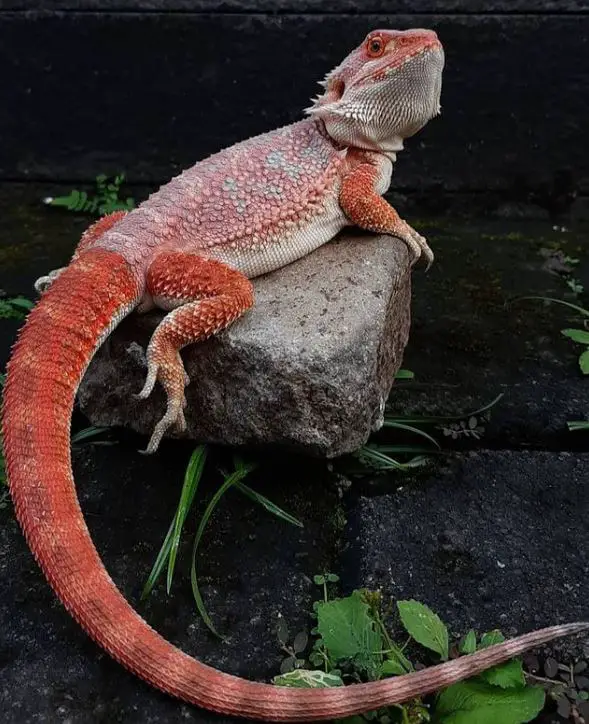
Bearded dragons use their body language to communicate with their own species and other animals. They will not imitate others, so their behaviors are always genuine.
The majority of bearded dragons will show their behaviors around females or when larger animals are around and they are threatened.
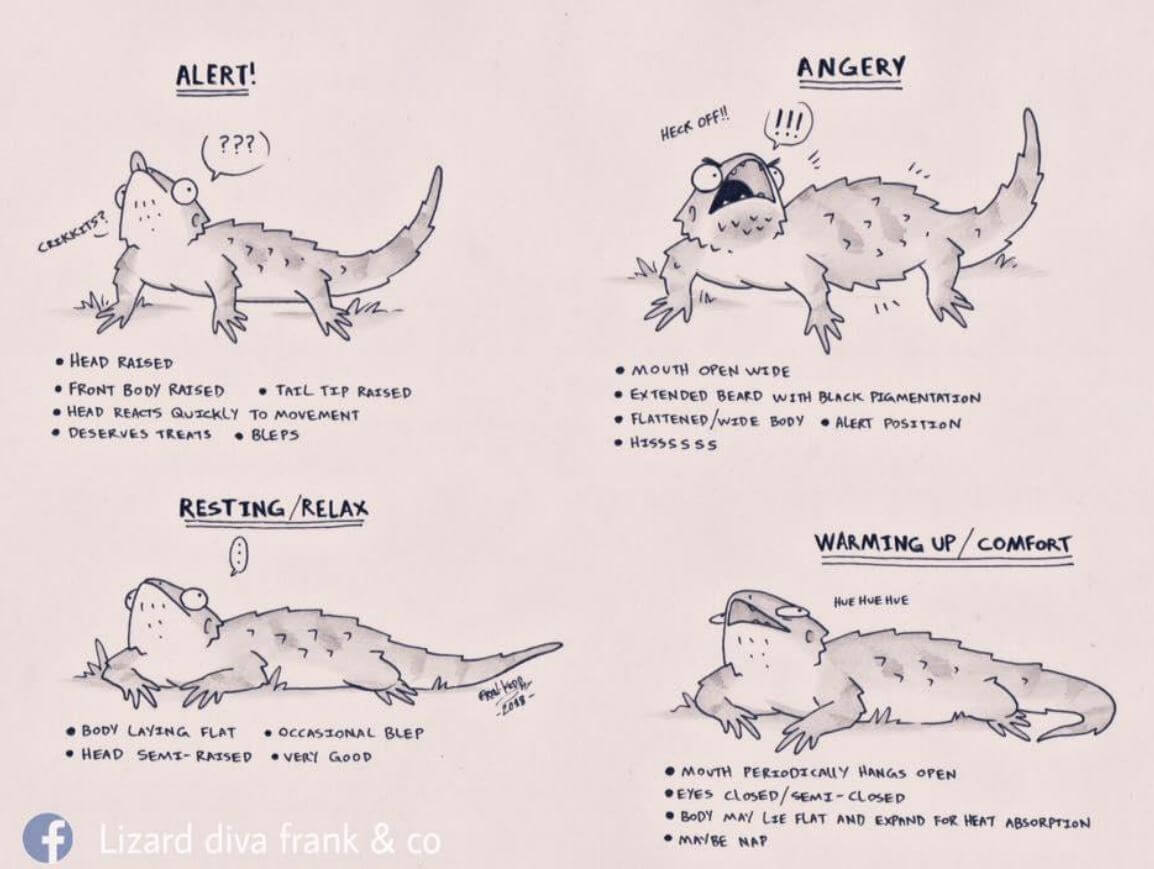
These cues are not intuitive to humans, so they need to observe carefully. By reading and observing bearded dragon body language, we can learn about them.
It is necessary to learn how to read the movements of your pets. There are some common behaviors, such as:
- Head bobs
- Waving
- Skin color changing
- Mouth gaping and opening
- Beard fluffing up
- Tail pointing up
- Basking
- Hiding
- Sleeping
- Relaxing
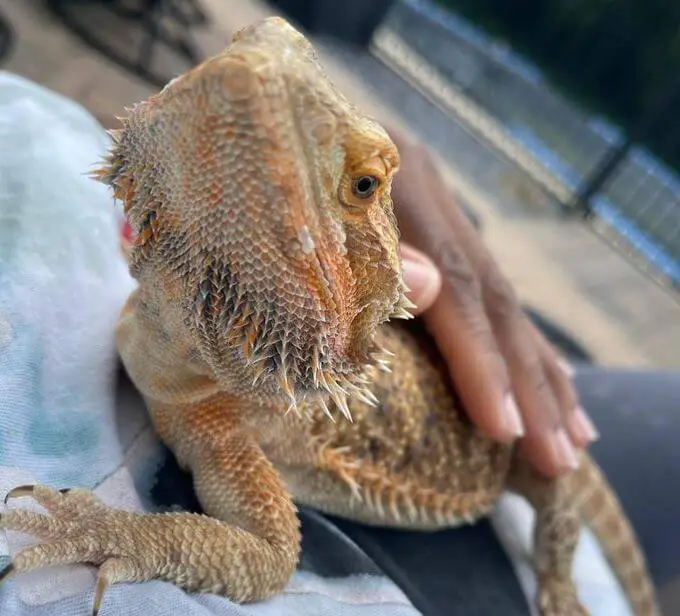
Moreover, such typical behaviors, when repeated or in a strange way, can be viewed as irregular.
For instance, while it is common for bearded dragons to turn black when they are excited, if the dark color is kept for a long time, it means they are in trouble or pain.
This is why bearded dragons’ strange behaviors need to be watched more carefully.
Are Bearded Dragons Territorial or Hierarchical?
Bearded dragons are territorial and hierarchical. They preserve the social order of the submissive or of the superior aggression.
Baby and hatchling ones sometimes do not show hierarchic traits or aggression. But their social behavior will start to develop as they grow up for far more than 4 months.
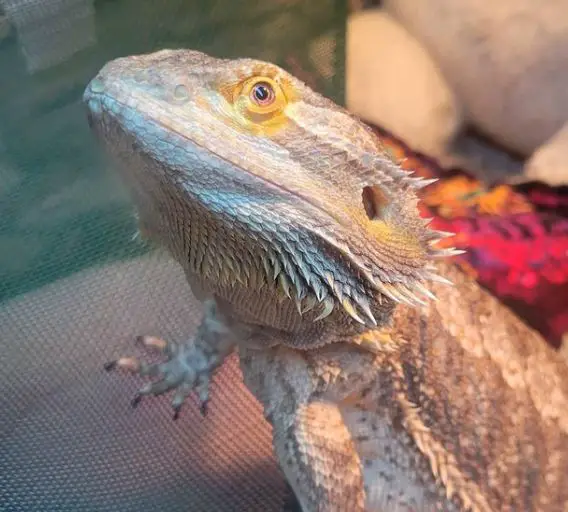
For example, the biggest or dominant beardie in a social group takes the best basking spots, like the highest one, while others are at the bottom.
The dominant one may even deprive the subordinate of the possibility to absorb UV light if the whole enclosure is not covered, and so on.
Finally, they will affirm the dominant by bobbing their heads and slowly or rapidly waving arms at the lower rank.
If the lower-ranked individuals do not show submission, a standoff is ensured.
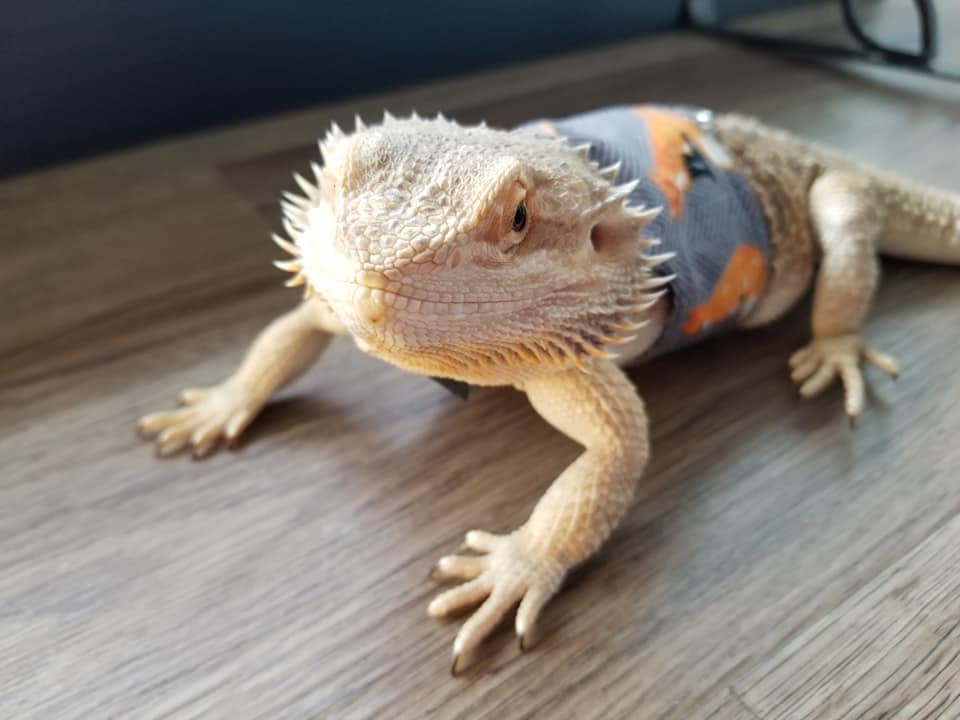
Furthermore, beardies are also territorial and competitive for basking places, food, brumation, etc.
The dominant beard will show an assertive stance, like swelling his beard or head bobbing, which prepares him to face another male over territories.
If the subordinate doesn’t admit or show submissive movements like waving his arms and walking forward, there may be a provocation.
Women are territorial, too, but head bobbing or beard puffing is not how it is demonstrated. It is determined by their size.
Since they are solitary, protective, and hierarchical, they are often housed separately, if more than one of them is accessible.
How to Read Bearded Dragon Body Language
1. Waving
This is the moment when the bearded dragon stands high on three legs and waves them in a circular movement.
Often, they raise their front foot and literally wave at you as you stand near. It seems like they just said hi to you.
When reptiles swing their arms, there are a few potential significances.
There are two main types: challenge waving and submissive waving.
One thing is the presence or the recognition of species.
When they wave to another dragon, it shows the other one that they are aware of their existence.
Submission is another meaning. Whenever a larger bearded dragon is confronted or when a bigger animal encounters the dragon, bearded dragons will wave their arm.
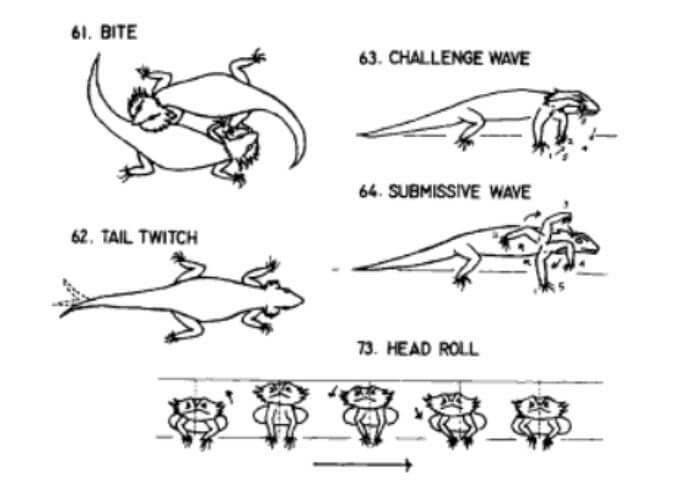
2. Head Bobbing
Head bobbing is a symbol of domination. It happens when the animal wants to create amongst themselves a social hierarchy.
More quickly, however, bobs can be used as an alert and a challenge.
This bearded dragon body language often appears in males. As male dragons court a female, they do jerky bobs.
Some of them bump obsessively when being in brumation, especially if they sense the female’s fragrance.
When a male dragon’s head bobs during springtime, their emotions are simply running wild facing a breeding season.
Beardies often do quick or slow bobs that look like they are nodding at each other or their owner.
The faster the head bob, the more threatened they feel. It is usually for territorial purposes that the reptile is head-bobbing rapidly over another one.
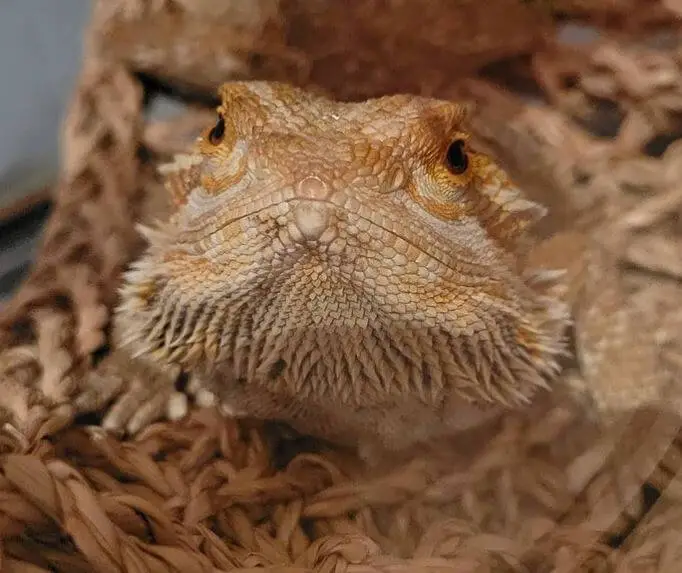
3. Skin Color Changing
Like most types of reptiles, fish, or amphibians, bearded dragons have what is termed “chromatophores.”
Chromatophores are pigmented cells that mirror light and allow them, when reacting to their surroundings, to change the body color.
It is important to remember that dragons will change color as they mature until they immerse themselves further in color changes.
Therefore, if your beardie gets darker or brighter as they get older, don’t worry, especially if this change happens over months.
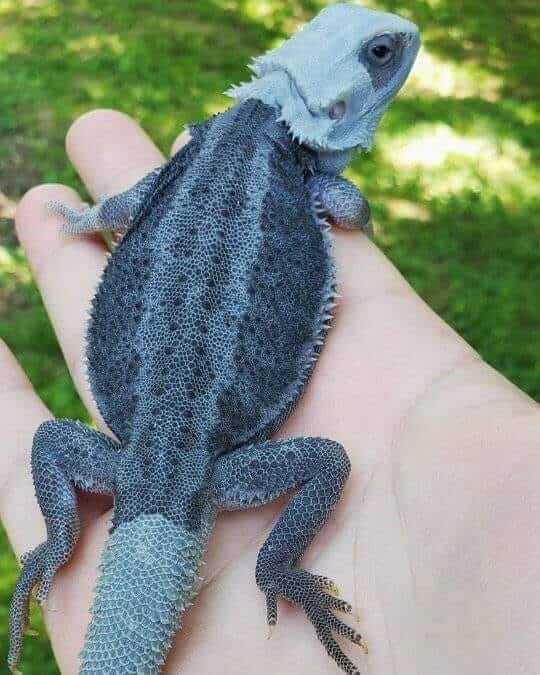
Why does your reptile turn black or white sometimes? Temperature control is the primary cause.
When a bearded dragon is under a heat source or natural sunshine, color variations more noticeably occur.
Along with faint tiger strips, some of these bumpy scales darken under the sunlight. Some dragons can also be lighter, with more striking color patterns.
When reptiles get darker, the heat they consume will be maximized. In a warm environment, black surfaces drain.
This is why in the morning, you always see the dragon turns black and flatten out when you light them, take them for a walk, or bask them in the natural light.
Any beardies will also become black if they become aggressive.
Nonetheless, blackened skin can also be one of the symptoms of stress or illness, in conjunction with other disease symptoms.
a. They feel cold.
Sometimes, when your bearded dragon feels cold, in an effort to attract warmth, they become black.
Even if they are in natural light or under the basking bulb, turning black means that they are trying to warm up.
You will also find at this period the dragon flattening out like a pancake.
This is a warm-up process since they like to expand their body, allowing them to gain more heat.
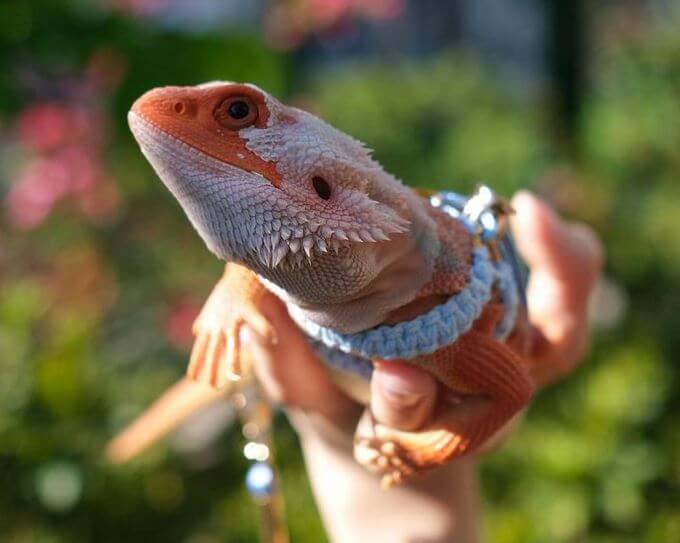
b. They are stressed out.
There are so many reasons that can cause stress to your pet.
Has something changed in the tank lately that might have made them feel uncomfortable?
Any there any feeders that may be biting them during mealtime?
Has something changed beyond the tank, like the existence of a new pet or even children, which causes more noise and upheaval?
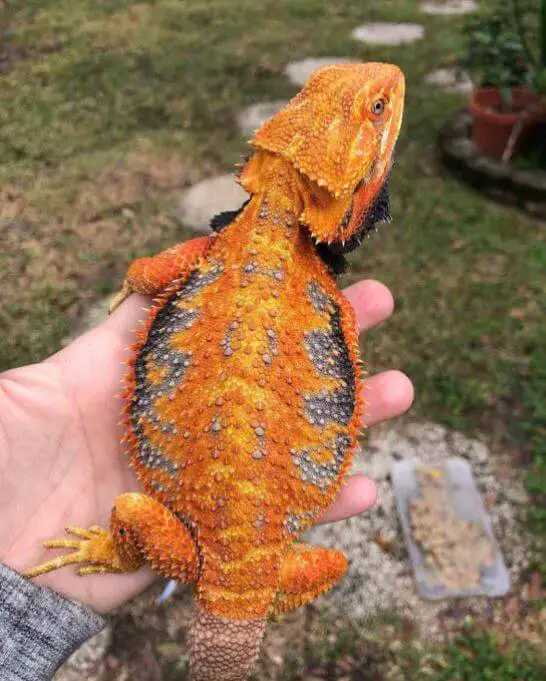
But note that it is also a symbol of a coming shedding when the reptile becomes pale. Also, as they sleep, they can get a bit lighter as well.
4. Basking
An activity that bearded dragons love to do every day is basking under a heat lamp or in natural sunlight.
They do that to accumulate heat and UVB radiation to build calcium metabolism by producing vitamin D3.
As mentioned above, to absorb as much warmth and UV light as possible, many of them like to flatten their bodies (thigmothermic basking) and become darker to soak.
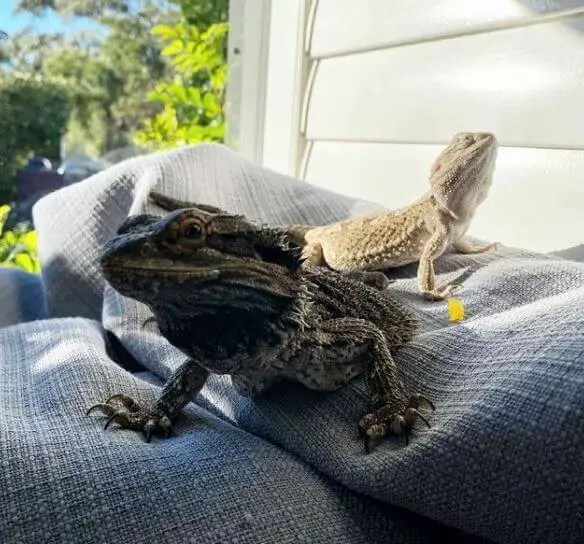
5. Fluffing the Beard
Both male and female bearded dragons spread their beards. They usually do so to make themselves seem larger as a defensive behavior.
It is uncommon if they stretch their beard without being provoked.
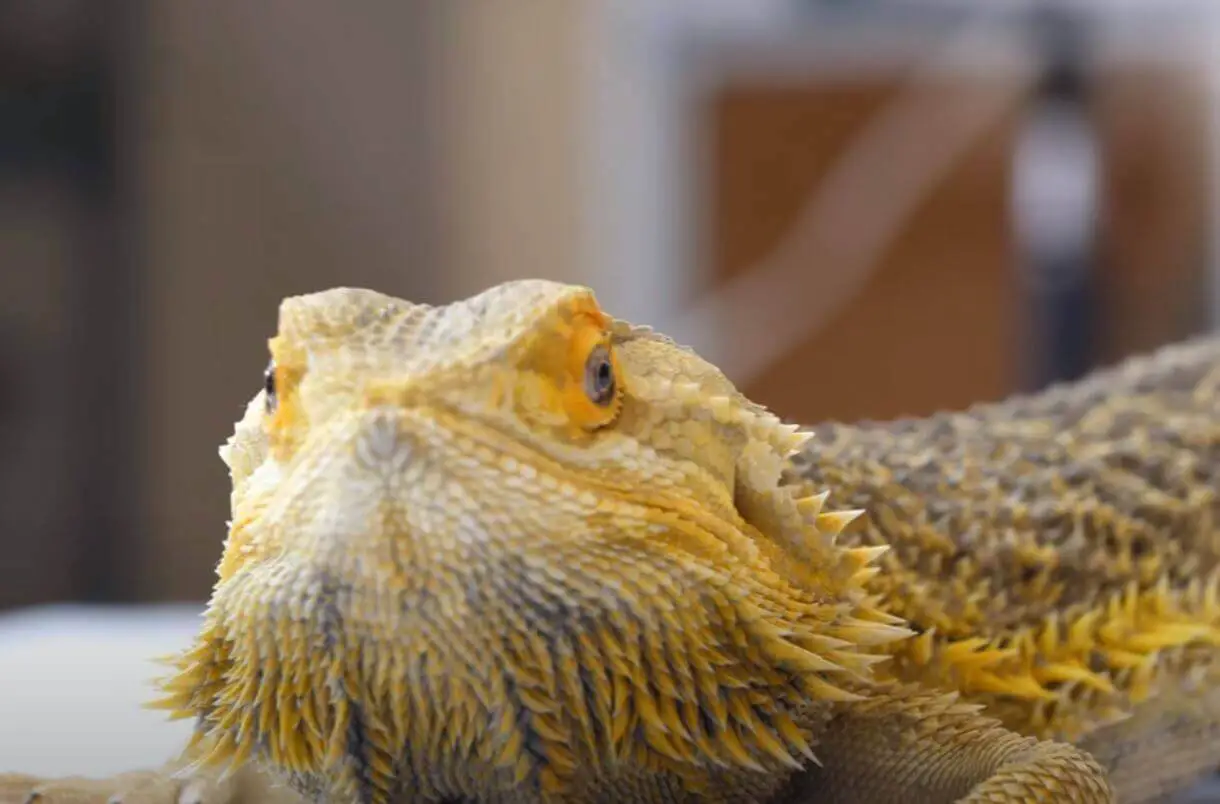
6. Hissing, Flattening, Inflation, Tilting
Bearded dragons are strong and feisty reptiles. For several reasons, they can get angry easily.
If they face a dangerous predator, they flatten their body, puff up their spiny neck and beard, spread their jaws, and tilt their body.
That makes them look and sound bigger.
Hissing is a warning signal. It is a way to warn the attacker that they are going to protect themselves when they feel threatened.
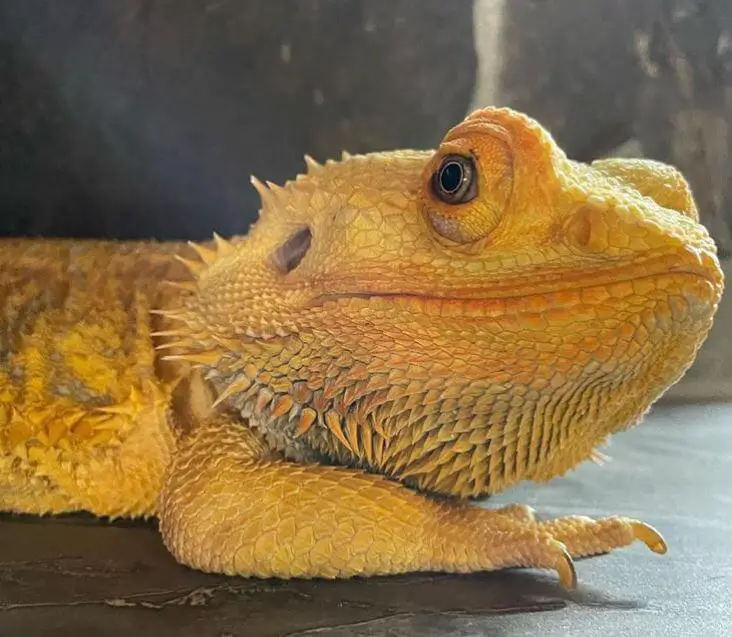
Their beard will become black at that moment. Often, hissing leads to biting, which is a simple presentation of violence.
However, considering the heavy jaws, they can hardly bite and it will be the final resort.
When they settle, beardies will lay down on their belly, widen it, and look like a pancake.
When you see this happen while the reptile basks, it means that they are absorbing heat.
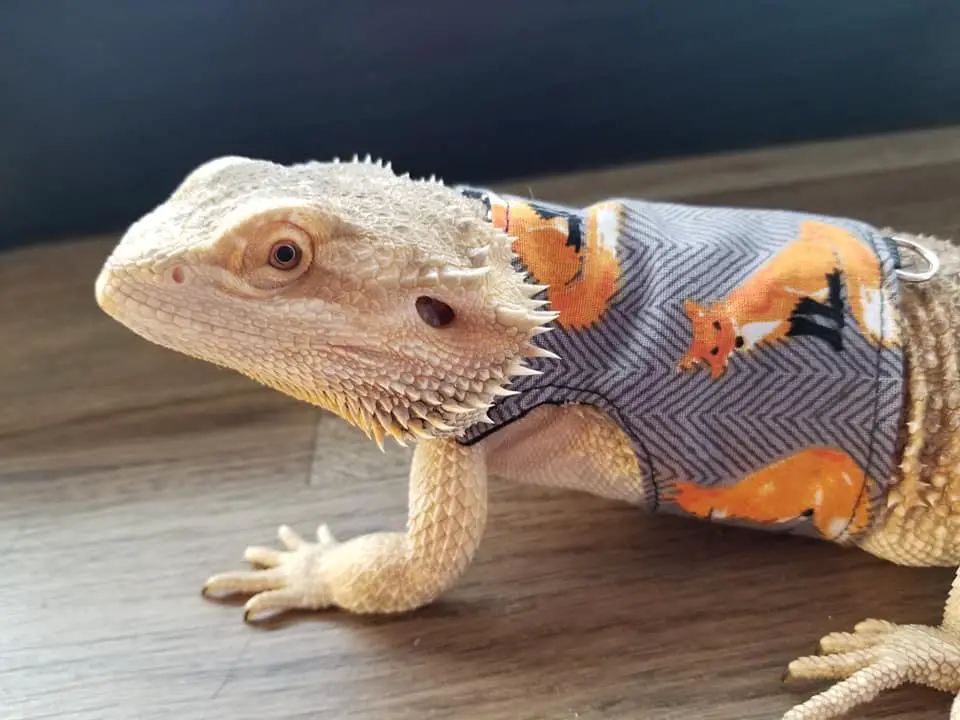
7. Bowing
The female ones will bow down to the ground, wave their arms, and run backward to hide or to please a dominant male.
8. Head Position
A low head position denotes submissiveness, whereas a high head position denotes assertiveness.
When the enemy is violently head bobbing at them, or when they are outdoors and see a large bird overhead, they will lower their heads.
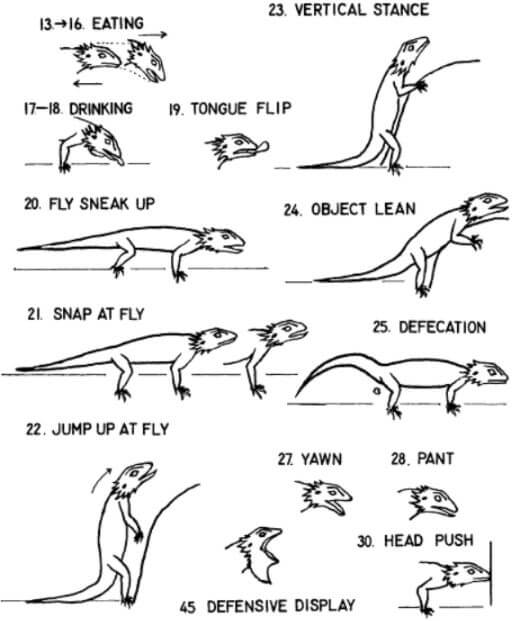
9. Tongue Flipping
If bearded dragons have their tongues out, they are most certainly exploring their surroundings.
This involves flipping the tongue in and out of the mouth and using the tongue gently to feel strange objects.
This is how bearded dragons learn about new places and creatures.
If you move them to a new home and find that their tongue is always out of their mouth, it is because they are learning about their surroundings.
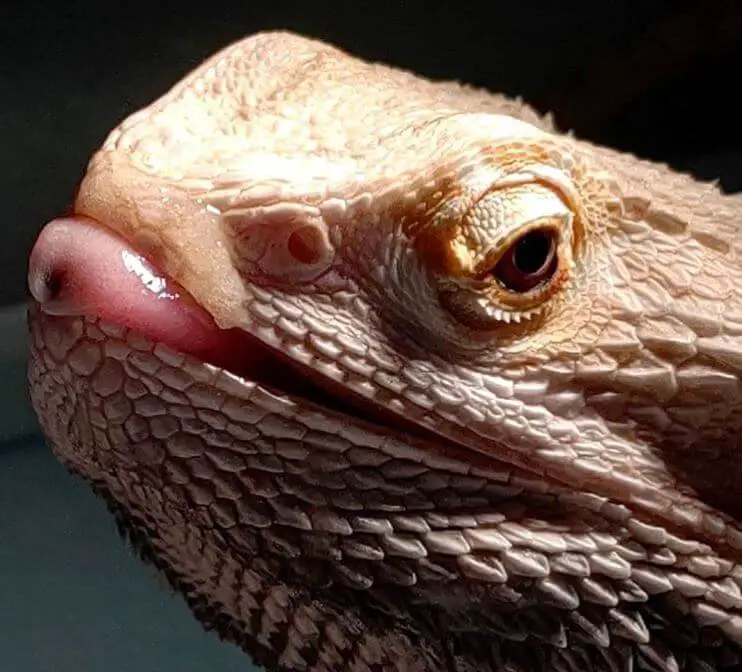
10. Mouth Gaping or Opening
The most common reason a beardie keeps their mouth open is to regulate the temperature of their body.
Bearded dragons sometimes open their mouths to avoid overheating.
In contrast to the other species, they cannot sweat, so they open their mouth whenever their body temperature is too high.
Opening mouths for a short time is entirely natural.
However, it can mean that the terrarium is too hot or that there are other fundamental health problems if it continues on for a long time.
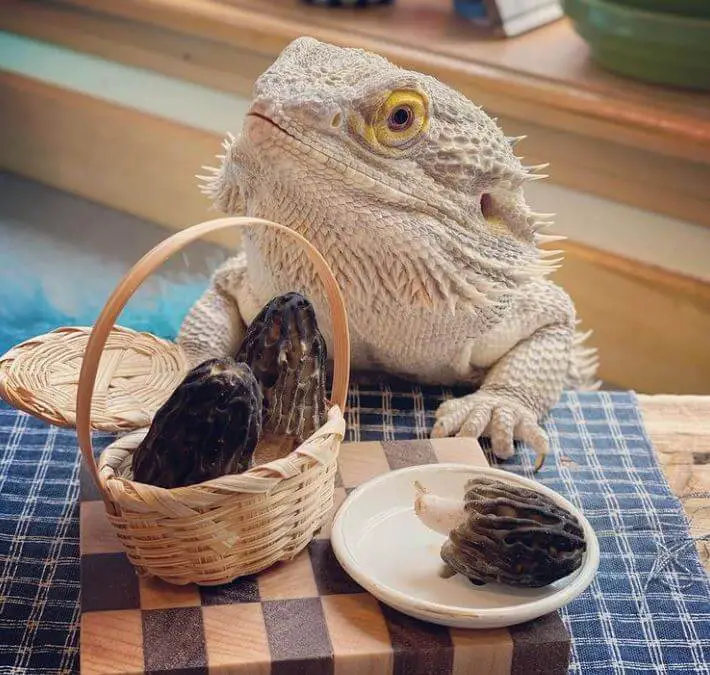
Sometimes, the beardies will also open their mouth when they see food.
For example, when they see a fly, you can see three stages of bearded dragon body language: fly sneak up → snap at the fly → jump at the fly.
If the mouth is gaping with heavy breathing, a respiratory infection can occur. Bearded dragons can have respiratory issues when held in high humidity.
Such a case may have other symptoms such as labored breathing, wheezing, etc.
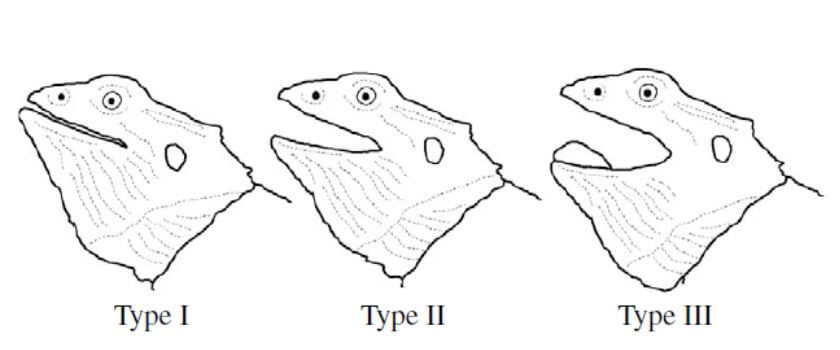
Moreover, gaping is also a way of protecting themselves against a perceived or unknown threat, even when you are holding them.
He will also swell his beard, hiss, or make small leaps or jumps.
Because of thermometric control, a thermal differential will often be created so that this animal may determine whether to be in the basking place or move to the cooler place.
11. Licking
Licking is one of the usual bearded dragon behaviors as they try to get to know their surroundings or taste something different.
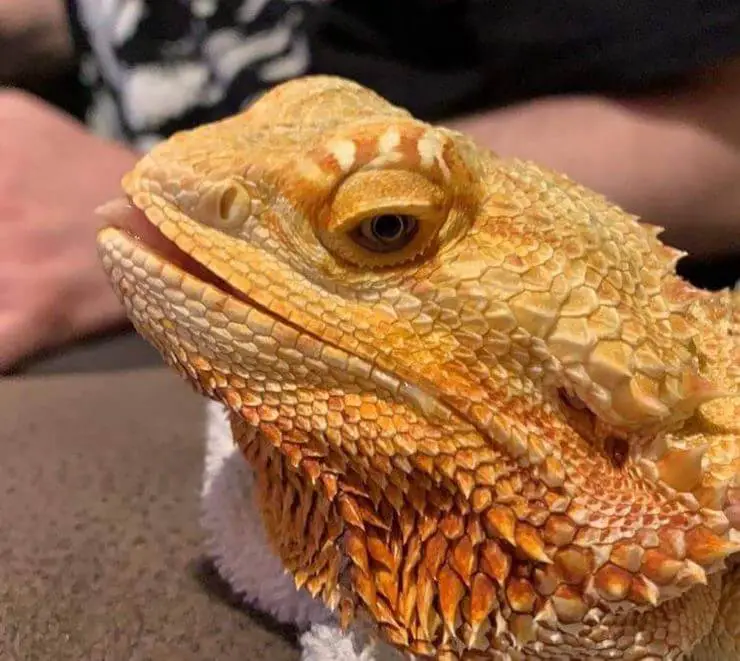
When Jacobson’s organ in his mouth licks and retracts, they taste and detect the scent of that object.
Some people notice that subordinate beardies may lick their dominance (called subordinate lick) as an indication of submissiveness.
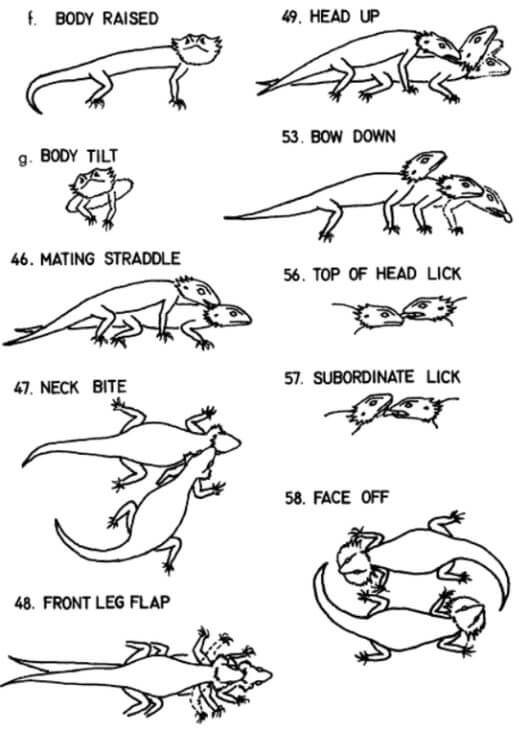
On the other hand, biting is a sign of attack. Although these pets can nip conspecific, they do not bite people except in special cases.
Nevertheless, in rare instances, it can happen if you attempt to manage them.
If the beardie displays signs of aggression when you try to deal with them, stop it and reduce the handling time until they get used to you.
12. Tail Curling or Raising Up
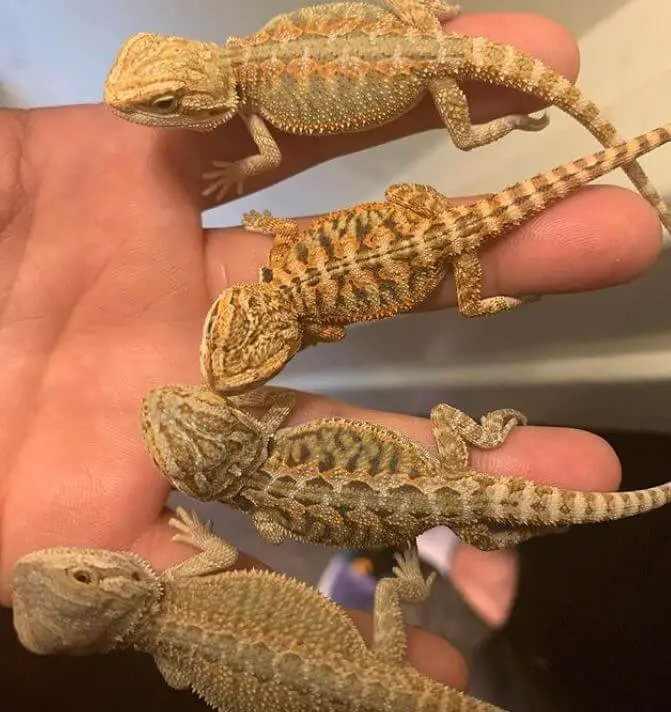
When you see them curl their tail like a scorpion, that is a general feature of alertness and even dominance.
Bearded dragons twist their tails when they are excited to chase the prey or rush for other reasons.
The tail curl can also be a response to temperature when they are placed in a warm environment or in warm water.
When they walk or run, most of the dragons curl up their tail like this:
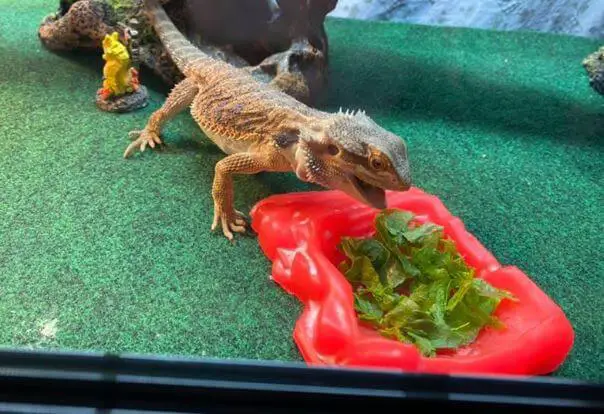
There is another bearded dragon body language related to the tail called tail twitching (like a cat’s tail).
Not all bearded dragons will do it, but it may be a sign of the attitude.
Many owners complain that their pet’s tail twitches when they kill prey and when they are stressed.
Often, during mating, two dragons can also twitch their tails.
13. Lying on Each Other
This might look like your dragons are feeling great with their wonderful friends. However, it is a symbol of actual dominance.
Bearded dragons require UV rays to stay healthy. Thus, the dominant one will try to get the maximum amount of UV rays as much as possible.
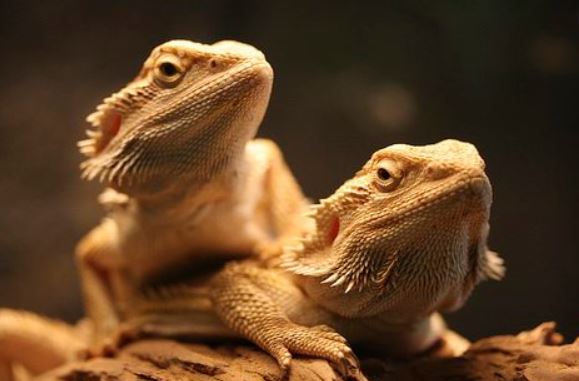
Hatchlings or babies may also lie on large ones while basking. Or, this can be a sign of mating straddle.
14. Eye Bulging
Young dragons bulge their eyes more and one explanation is that the skin stretches either as or after shedding.
When they are young, they want to tighten their skin more that’s why they do this.
In some cases, they will yawn like certain horned lizards squint blood after accumulating in the eyes of evolutionary behavior.
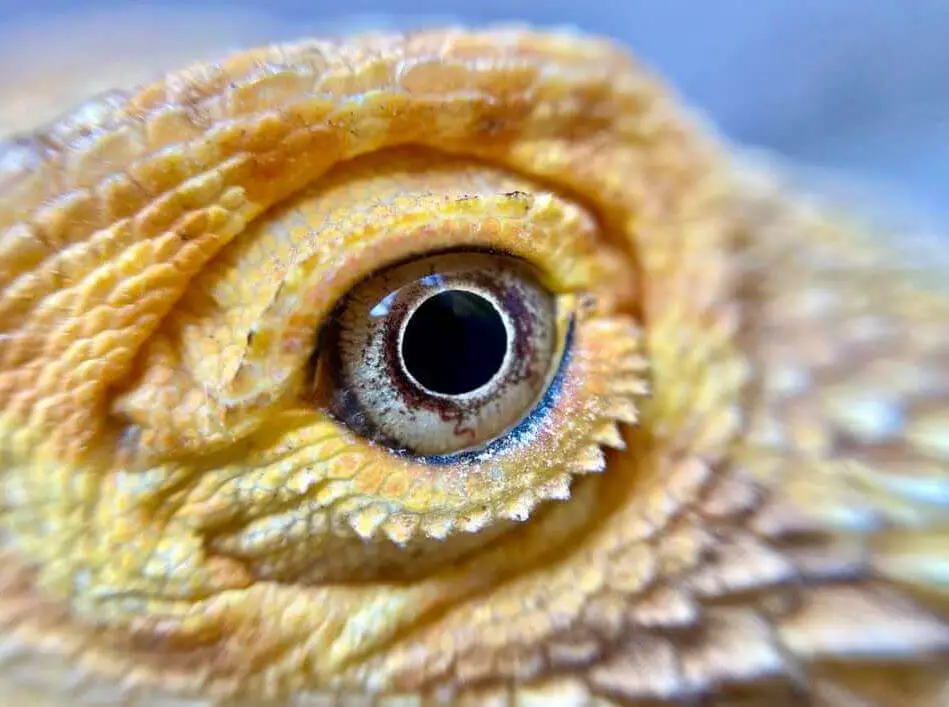
As in the case of a chameleon, it can be indicated as high blood pressure symptom if it occurs for a long time (more than 30 minutes).
However, unless any signs such as tearing or long duration are associated with it, you do not have to worry too much.
Finally, it may be a sign of infection or injury, especially if it is swollen, infected, or sore. Loose substrates such as sand can get into the eye of the lizard, causing discomfort and irritation.

15. Yawning
Bearded dragons yawn all time. It is a bearded dragon body language that consists of blowing the beard a few times and opening up and closing the mouth, which may appear like hiccups.
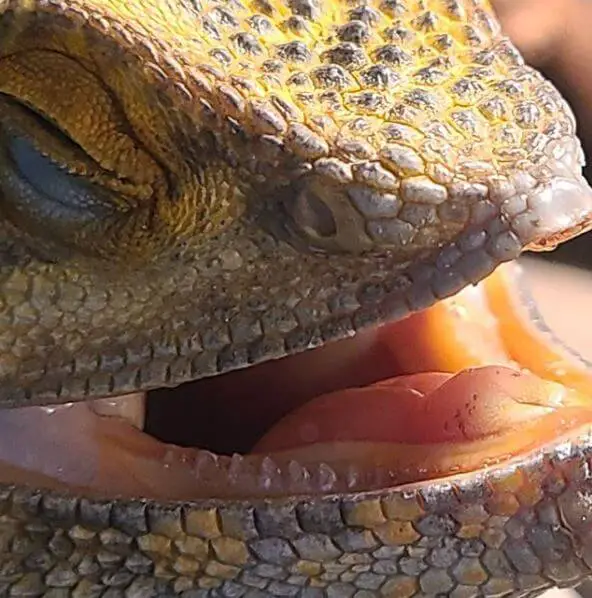
16. Climbing
As semi-arboreal species, bearded dragons enjoy climbing very much.
They do not live on trees. However, in addition to basking and exploring, climbing makes them feel better as they can see from a distance.
Any rough surfaces also support them in nail wear.
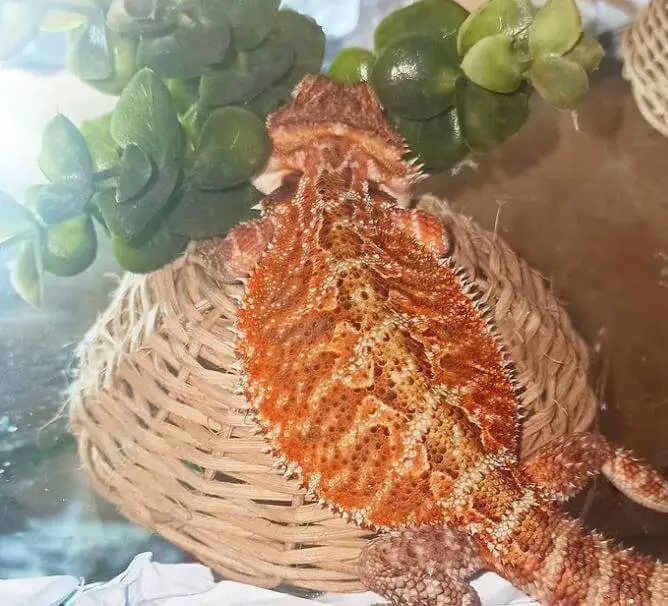
In the wild, beardies climb on rocks, trees, grass hammocks, branches, or any suitable surface.
Do not forget to give them trees and logs to climb in their captivity habitat.
Be sure you are using safe wood to allow them to access the heat and UV lamps as they may be burned if not careful.
17. Glass Observing
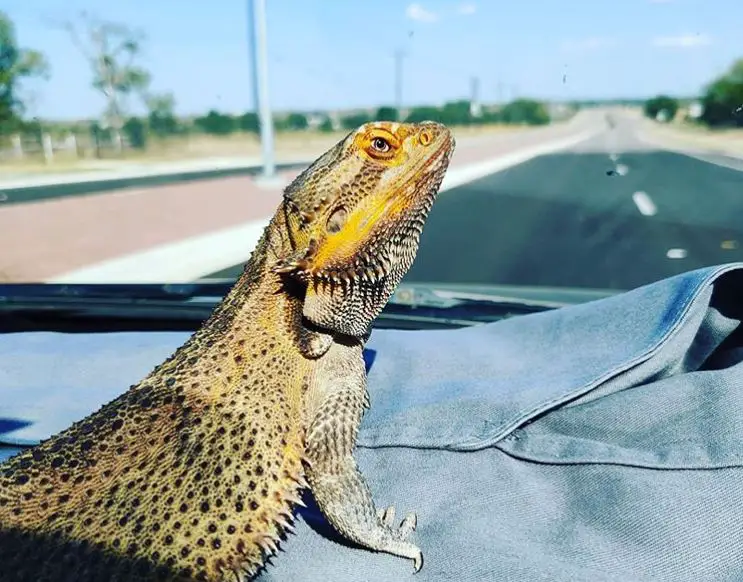
Glass observing involves scratching, leaning on, or trying to climb from the enclosure walls, especially the glass terrarium types, while standing on their hind legs.
They can even try to jump on the enclosure walls back and forth.
Glass observing normally means that something about the environment stresses the animal.
While many beardie owners think it is because they are interested or excited to see their reflection, in most cases, it is not.
This strange behavior is an indicator that something is not well.
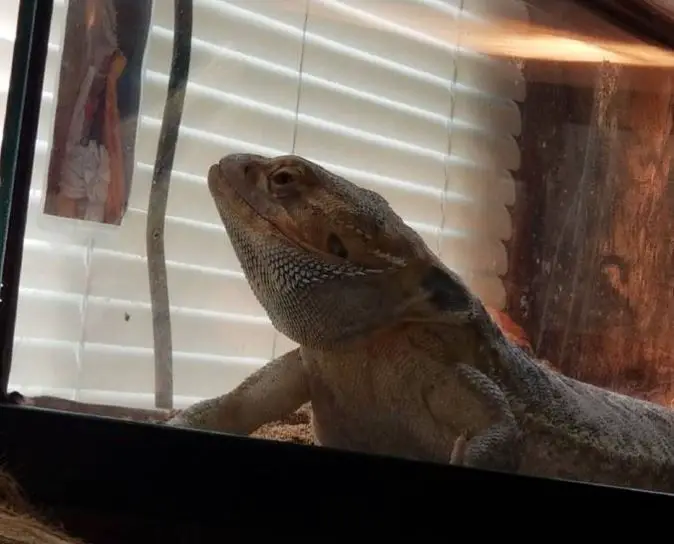
This can also be a sign of fatigue or boredom, but also of problems like wrong temperature setting, too small terrarium, a vision of an apparent danger as a dog or cat, seeing another beardie, etc.
A beardie who is always taken outside and loves climbing glass can even climb over if he wants to walk out of the tank, too!
Even though it might seem fun to watch, make sure that the tank’s edges are not sharp since it can cause the pet pain.
18. Staring
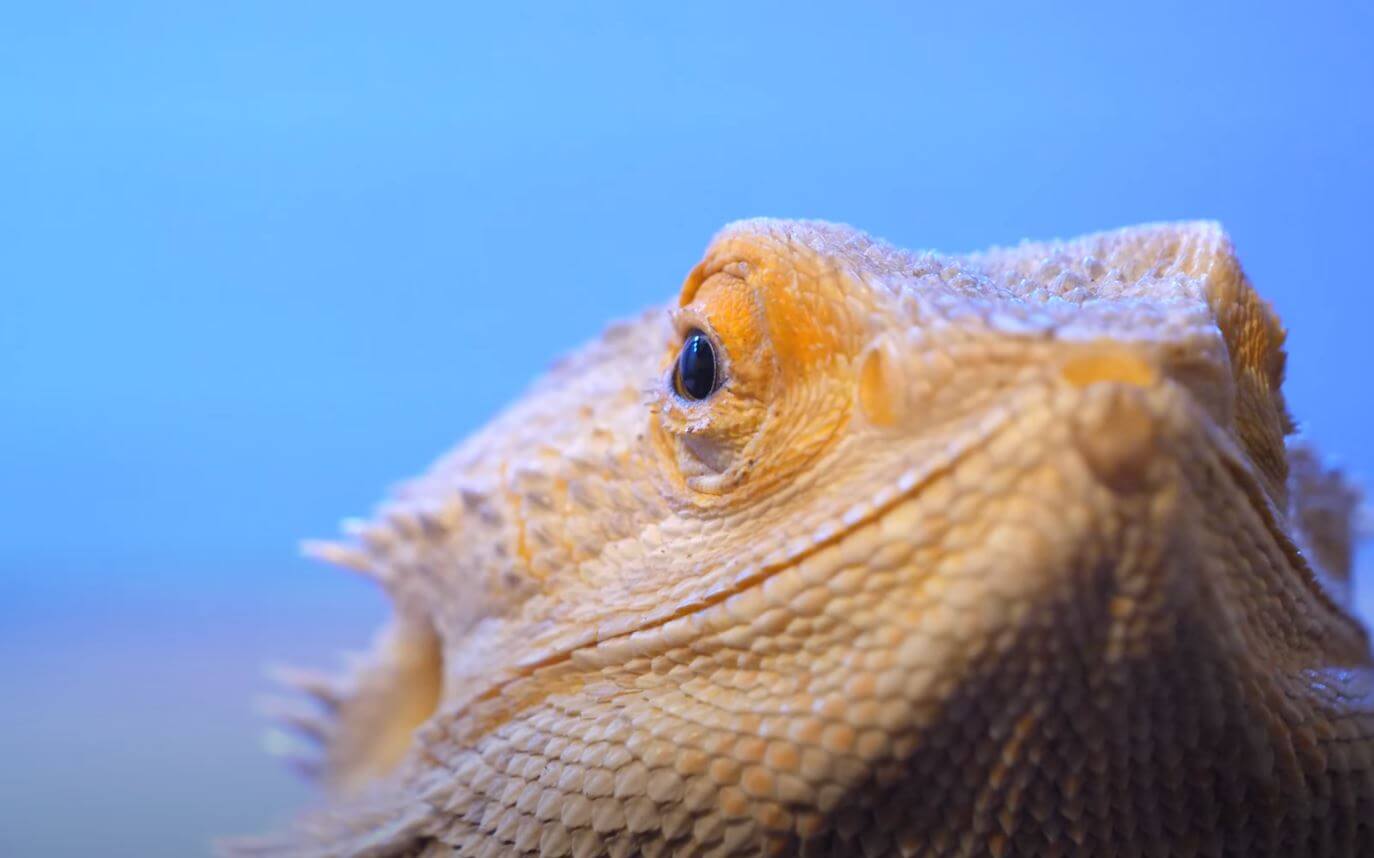
Beardies enjoy staring and looking at objects to figure out what they are.
Watching stuff provides them with a lot of amusement and security. If they feel interested in something, they tend to have a positive orientation to that thing.
However, when they show an investigative look together with an object lean and even a vertical stance, they may feel unsafe and want to observe it before deciding whether to approach it or not.
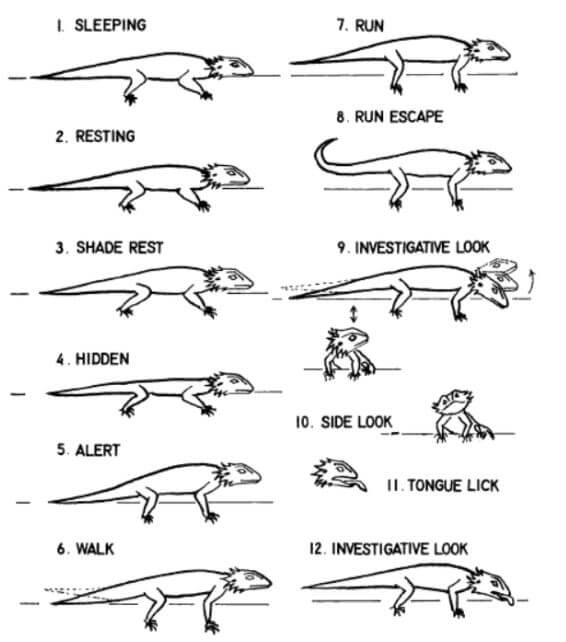
Bearded Dragon Body Language on Some Certain Occasions
1. Basking
Basking has two common types: thigmothermic basking (flattening his body like a pancake) and heliothermic basking.
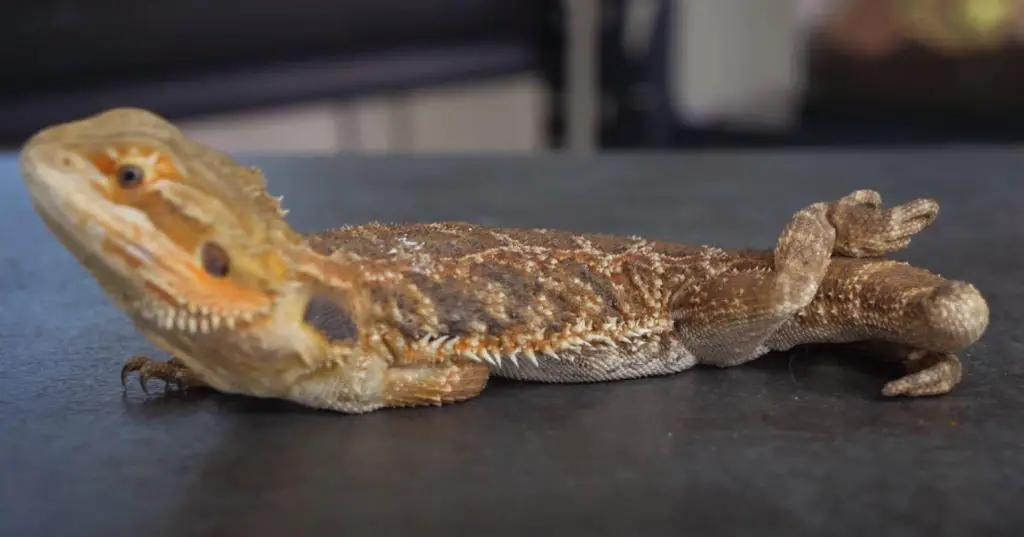
By nature, bearded dragons like to bask in the morning and late afternoon. They do this to absorb some warmth from the natural sun.
You can see them being good climbers on high and exposed rocks, branches, broken and falling trees, posts, etc.
However, when it gets too hot, they will hide in burrows and shaded areas such as rocks and grasslands or under logs to relax.
In captivity, these animals require a basking spot. This could include rocks, tree branches, hammocks, and so on.
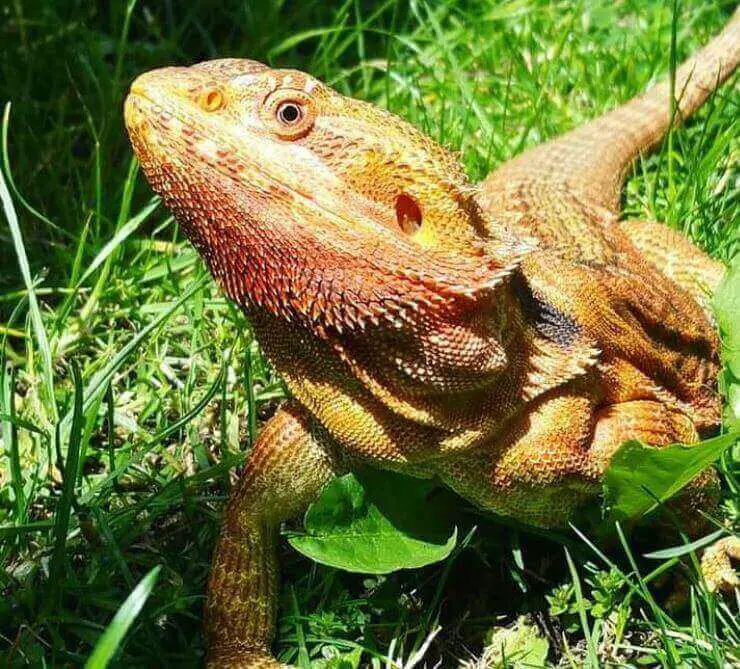
In addition, ensure that the correct heat lamps and UV light sources retain the correct temperature. Thermometers are useful to make sure the right temperature is preserved.
Finally, do not forget to provide a thermal gradient. This will allow your pet the opportunity to move away from their basking spot.
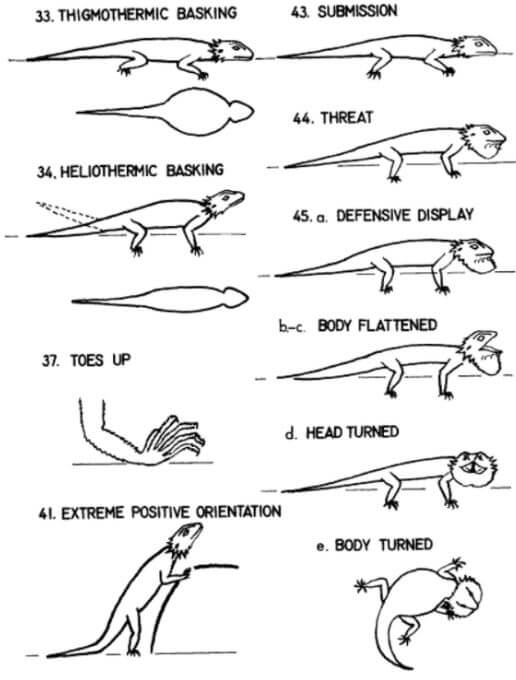
2. Digging or Burrowing
Digging is one of the normal bearded dragon body languages that they take part in even in the wild. Some reasons why they dig are:
- When the female ones are carrying eggs and want to lay an egg. Infertile eggs may also be put on by women without exposure to men.
- They will burrow and hide in the substrate as they are about to brumate to prevent extreme weather factors.
- If you do not have a thermal gradient and protected areas in the tank, beardies will dig to find a cooler hiding space. Ensure that you have simple furnishings and decorations like a hideout in the box.
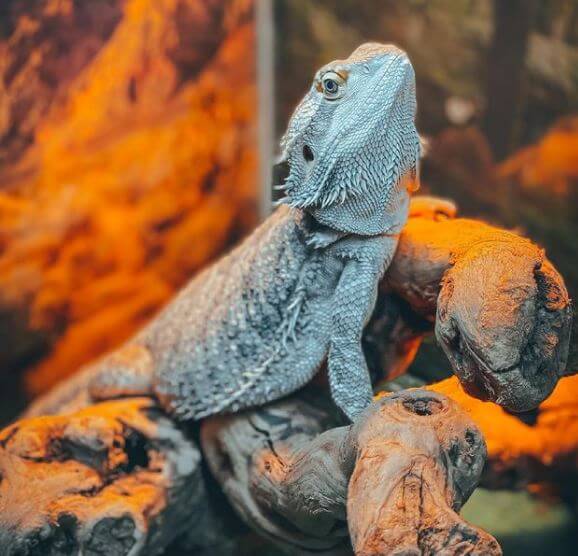
- If they are stressed and want to disappear or be alone.
- They want to build a cozy place to relax if the tank does not have basking spots.
- They try to tunnel out and escape the tank.
Digging is one of the activities they enjoy. But if they always dig for no particular reason, it may be a behavioral problem.
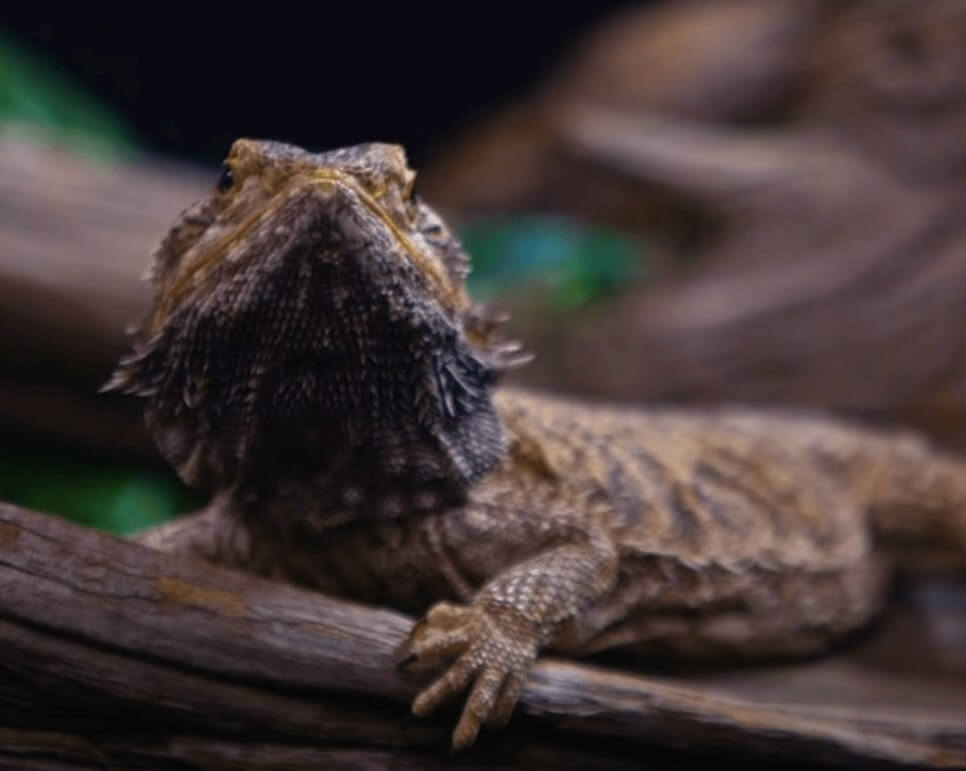
3. Brumation
Brumation is one of the ways of hibernation for reptiles. It happens during autumn and winter.
But unlike other animals, reptiles don’t cut off metabolism entirely. They slow it down instead.
Each dragon brumates differently and maintains various activity levels. However, during brumation, all reptiles must be kept hydrated.
When brumating, the beardie will sleep for months.
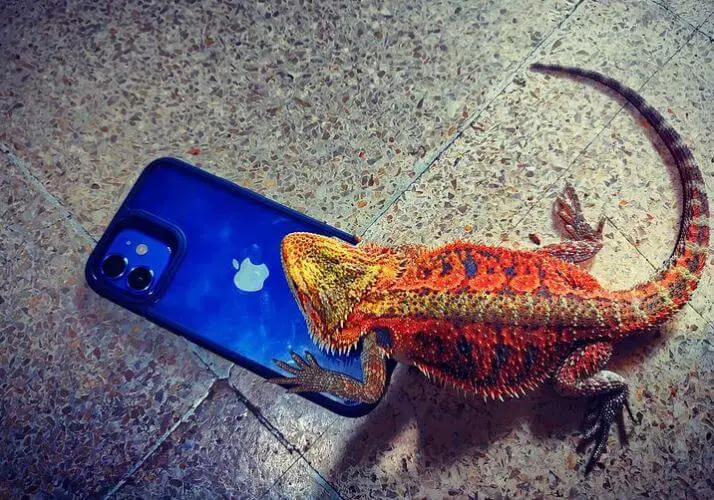
During that time, they can’t eat or drink too much or at all. Don’t expect them to have plenty of appetite at that time.
Brumation is a normal and unstoppable procedure. If they surf post-brumation, they will be a little bit lethargic.
How Can You Know If Your Bearded Dragon Is Going to Brumate?
A drastic change in behavior is the first sign of brumation. You can see your pet acts like these:
- More naps and look sleepy
- Like to hide
- Sluggish movement
- Lack of appetite
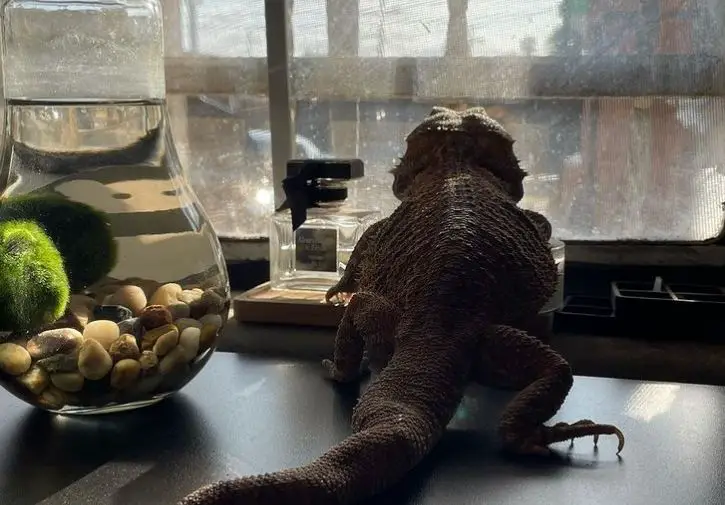
When a bearded dragon is ready for brumation, they should look healthy.
They may become lazy, but they still have a clean and elastic body and bright eyes, and no mouth gaping or infections.
When reptiles try to brumate out of season, like in the summer, their health will be damaged and their behaviors will mimic brumation.
The effects would be the same if they did it while they are under one year old.
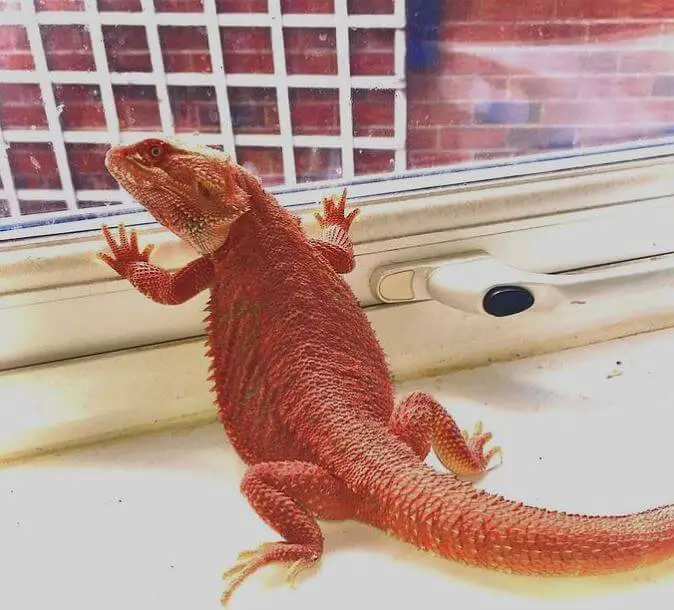
Low UVB lighting, inadequate temperatures, and insufficient vitamins and minerals have a negative impact on their health and behavior.
Moreover, an overdose of vitamins, especially those with vitamin D3, or infections can all lead to brumation-like behavior.
The unhealthy symptoms should be dealt with as soon as possible. During the brumation period, sick beardies sometimes die.
Fortunately, you as the owner can do certain things to ensure that your pet is safely hibernating and can wake up later with a lot of strength.
What Will Happen After the Hibernation?
Some beardies take a week to go back to their normal life, and some longer.
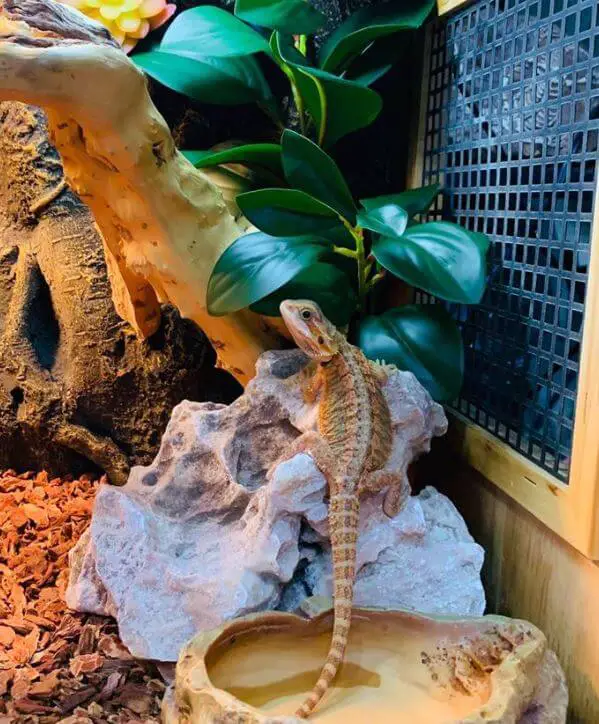
Nonetheless, during this phase, your dragon may have an unusual sleep cycle and random energy shifts.
They will soon be awake if you see those signs. Don’t be surprised if they act lazy and take long naps, only to wake up later with lots of power.
If your bearded dragon seems keen to get out of their tanks, you shouldn’t be concerned. That is normal after hibernation.
4. Shedding
If the reptile is cranky or reclusive, he may be preparing for a shed. Shedding is a natural bearded dragon body language.
Reptiles in general lose their old skin little by little in big patches or all at once.
You may find that they don’t want to be handled or they seem unhappy and fidgety during this time. They also turn darker in color a little more than normal.
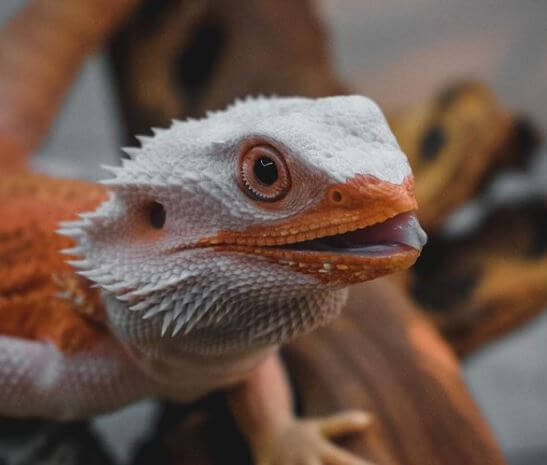
Also, they lack appetite as well. So, if they do not eat a lot, don’t worry unless it continues for more than a few days.
Shedding is a phase reptiles undergo once they outgrow their old skin. This helps young beardies grow quickly.
The whole process can last for 3 to 10 days. During this period, their look will change.
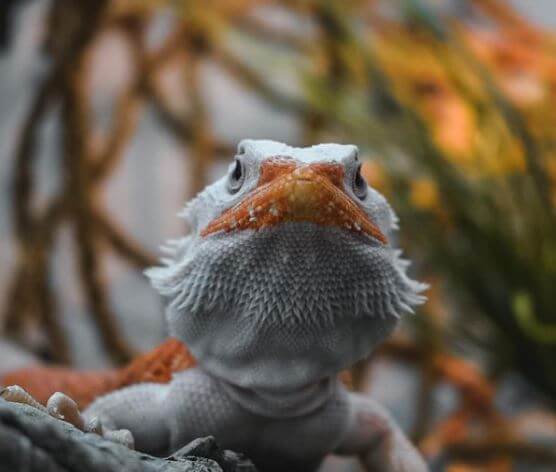
How to Help Your Bearded Dragon When They Are Shedding?
There are some ways you can help your beardies with their shedding:
- Soak them in warm water and gently scrub them with a soft toothbrush.
- Spray water to mist their body.
- Don’t try to bother them too much.
- Even though it can be tempting to tear your beardie’s skin off, never do so until a piece of skin is totally loose. If any resistance exists, stop doing it.
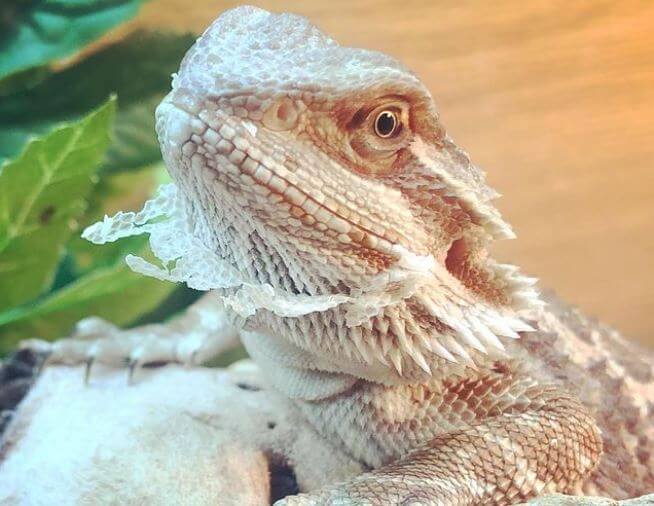
Many products can be used to help the shedding of your pet. These may be useful if their shedding process finishes incompletely.
Do you think they are having a rough shed?
Help their scales recover by adding a few drops of betadine iodine to a dampened cotton pad and applying it on the hurt spots once a day followed by an antibacterial cream.
You can also add raw unpasteurized honey once a day.
5. Laying Eggs
Female bearded dragons can lay eggs on their own, even without any contact with a male beardie. But the eggs will be infertile.
In the weeks before they lay their eggs, whether fertile or infertile, they will probably show some particular habits.
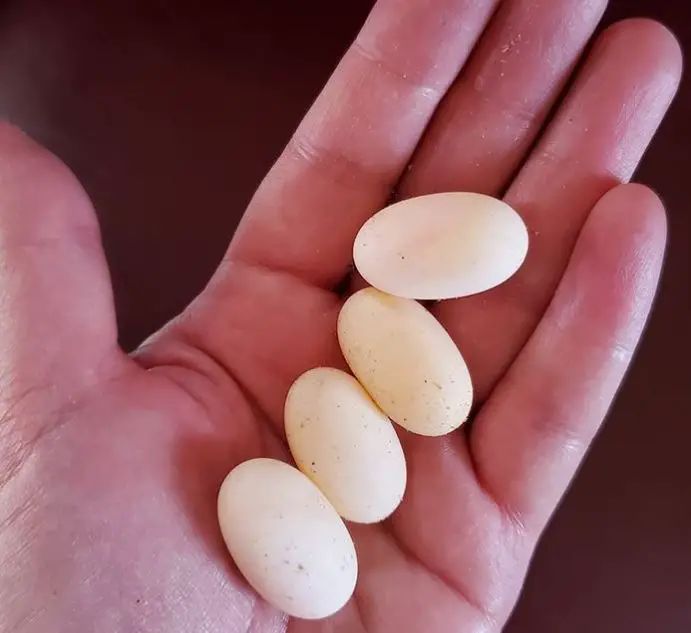
For instance, you can find her sitting under the heat lamp, lethargic and less active. Then she will start scratching inside the enclosure while she gets ready to lay her eggs.
If you suspect that your bearded dragon is gravid and is going to lay eggs, you may want to ensure that you put her in the lay box and provide enough food, lighting, and heating to keep her safe and healthy.
Bearded Dragon Body Language: Aggressive Behavior
Beardies display signs of aggression or defensiveness. It may be because of territorial attacks and they want to defend their turf.
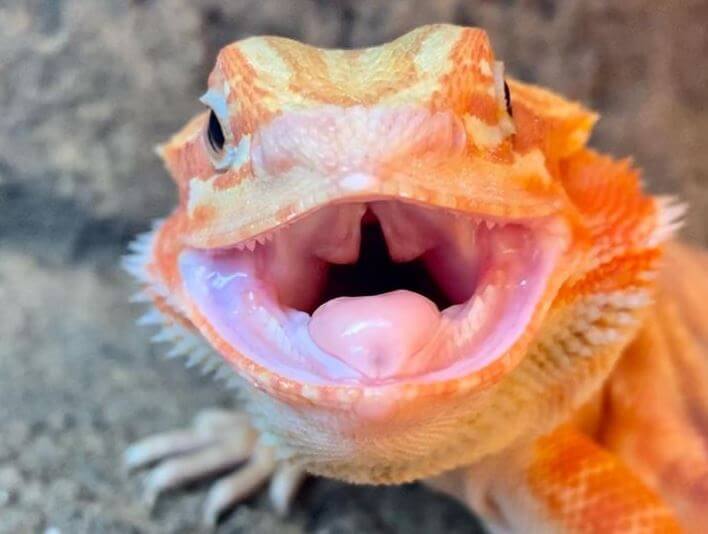
Common signs of provocation include hissing (when they feel threatened), biting, and beard fluffing (the faster they do it, the more intense the hostility is).
A combat stance, circling, and biting can occur if not disrupted. Split these reptiles often in order to prevent them from fighting and causing injuries to others.
They will fight even until they or others die.
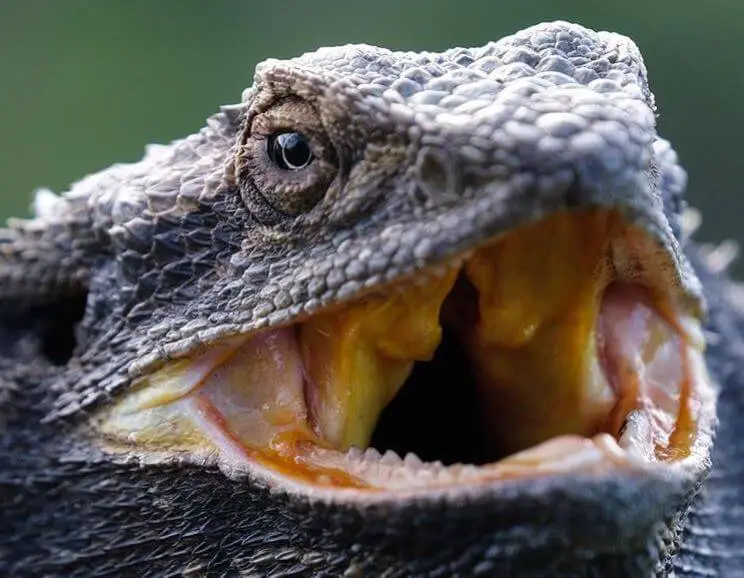
Bearded dragons are not offensive by nature. They will exhibit signs of aggressivity and threaten to bite you if you try to provoke them.
Both male and female ones have some of the most prominent symptoms of aggression.
1. Beard Fluffing
A beardie will fluff their beard if they want others to know that they are ready to fight. Fluffing makes them bigger and more menacing.
Sometimes, when they fluff, their beard can turn darker or even black in color.
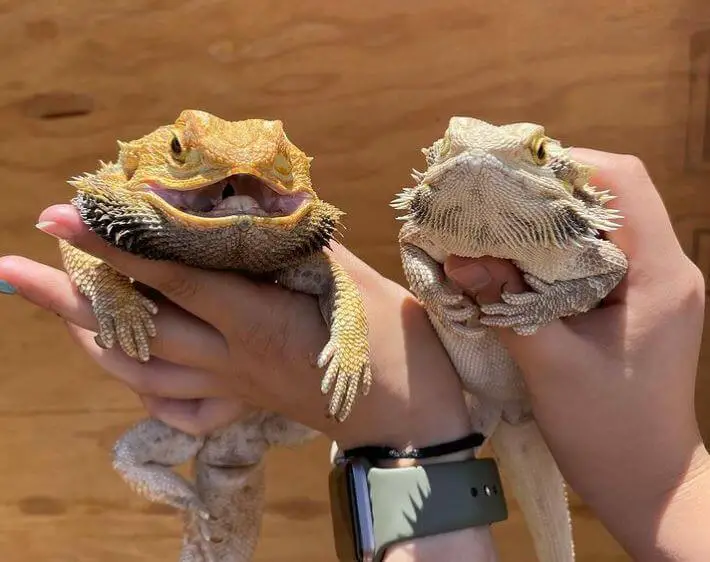
2. Hissing
The animal will hiss if they are being attacked. This is another sign of discomfort or provocation.
3. Biting
If your pet wants to bite you as you handle them, you can’t do anything about that. Wear a pair of gardening gloves because they will remain aggressive no matter what you do.
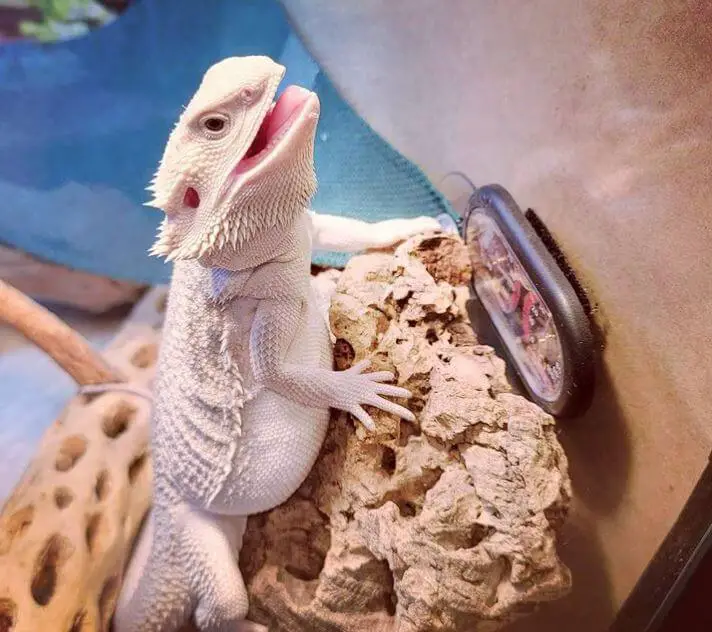
4. Bobbing Head
Bearded dragons bob their head up and down as a form of territorial provocation or to communicate with other beardies.
For example, one animal may bob four or five times very fast, and the other one may do that twice slowly in response.
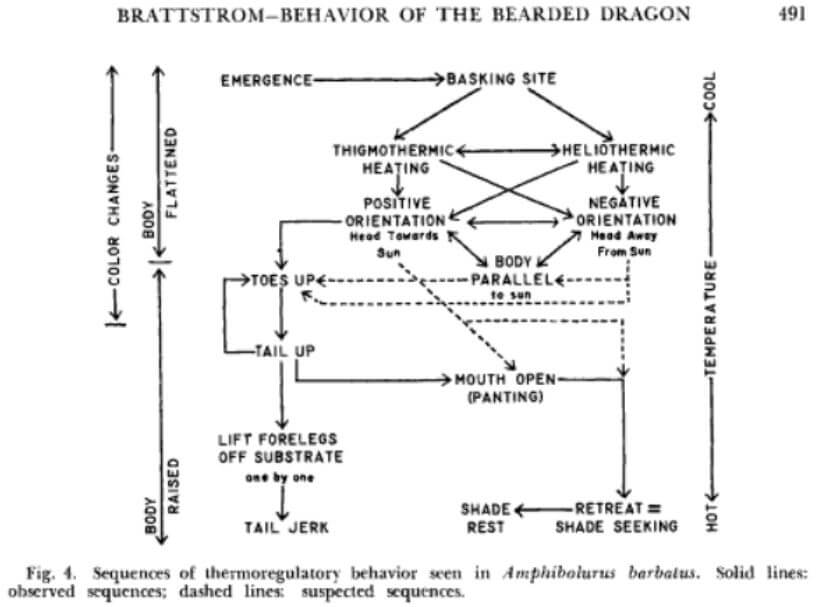
Bearded Dragon Body Language: Signs of Getting Illnesses and Diseases
Bearded dragons can also get sick like any other animal. Several diseases are especially prone to them. Luckily, most of them can be avoided.
So, what kind of diseases do bearded dragons carry with them? The most common ones are mentioned below:
- Viral respiratory infections
- Metabolic bone disease (MBD)
- Atadenovirus
- Mouth rot
- Parasites
- Photokerate conjunctivitis
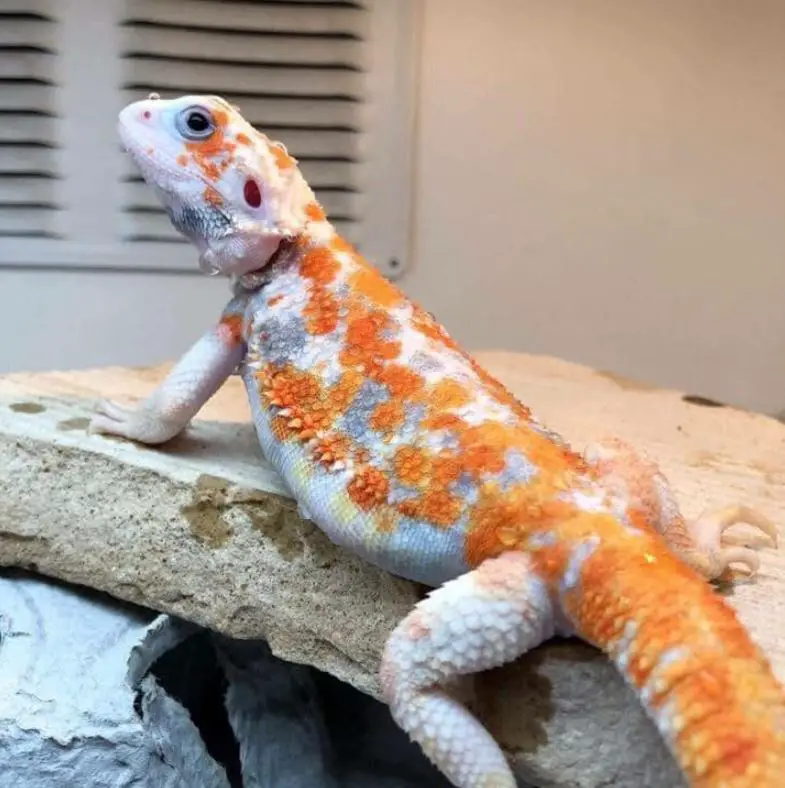
1. Respiratory Infections
To bearded dragons, respiratory illness occurs in too-cold, too-hot, or poorly ventilated living environments.
Stress, poor diet, and overcrowding can contribute to respiratory infection. Here are the most significant symptom of lung diseases:
- Hard and raspy breaths
- Exhalation of coughing
- Mucus on the nose and the mouth
- Mouth gaping
- Lethargic
- Appetite loss
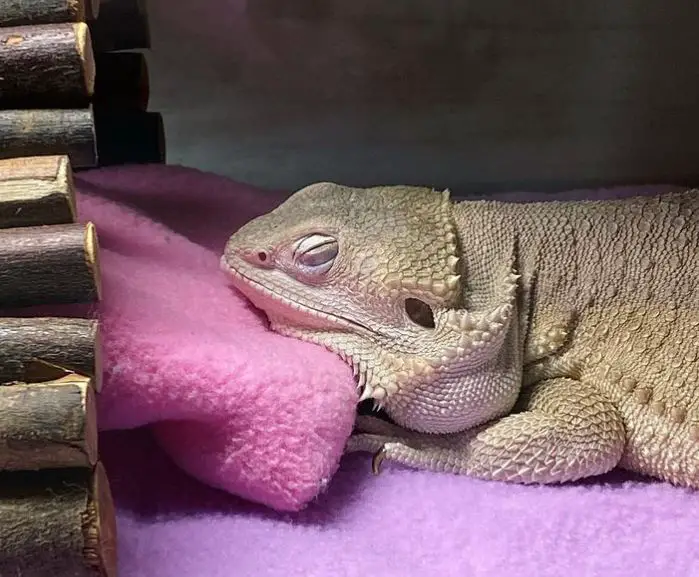
It is always better to deal with the possible cause of respiratory infections urgently. Check the temperature and humidity content of the tank and adjust if needed.
Treatments from a vet are required for most respiratory infections. Injections or oral doses of antibiotics are most often administered to your beardie.
Please do not try any home treatments rather than just sorting out their living space.
2. Metabolic Bone Disease (MBD)
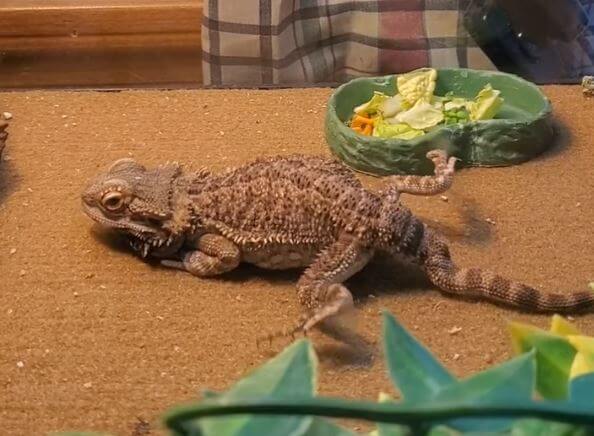
The most common sickness related to metabolism in captivity diurnal lizards, especially bearded dragons, is a metabolic bone disease.
It is a weakening state that leads, if not treated on time, towards gradual and painful death.
Metabolic bone disease is caused by a deficiency of calcium and vitamin D3. The bones begin to collapse, leading to defects, paralysis, and death.
It happens due to poor diet and additional or incorrect UVB lighting.
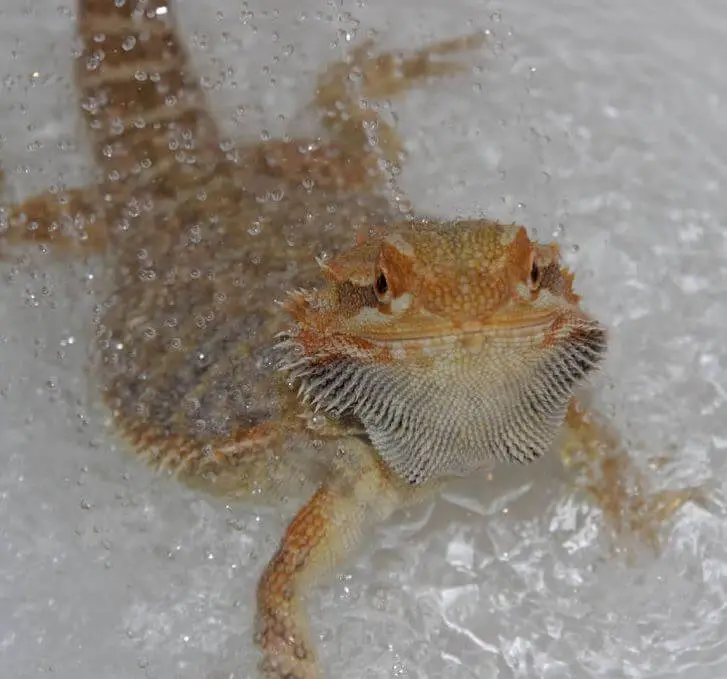
If the condition progresses, these signs of MBD become serious:
- Finger, foot, and legs trembling and twitching
- Hard nodes on the back
- Weakness
- Hind legs paralysis
- Slow growth in young dragons
- Lower jaw receding
- Poor bone fractures
If you suspect metabolic bone disease early, it can be treated quickly and easily.
The prevention and care must be maintained with quality nutrition with ample calcium, UVB lighting, and the right temperature and humidity level.
Check out this video on how to treat MBD bearded dragons right:
3. Defecation
A bearded dragon’s normal poop can look like bird droppings, but they may have a different appearance.
Lizards have two separate parts: one is black and the other is bright pink or white.
White sections are simply urates, not poop. Their bodies pass the urine in dry form as a result of the need for water conservation.
If the urates are yellow, your animal can get too much protein from their food.
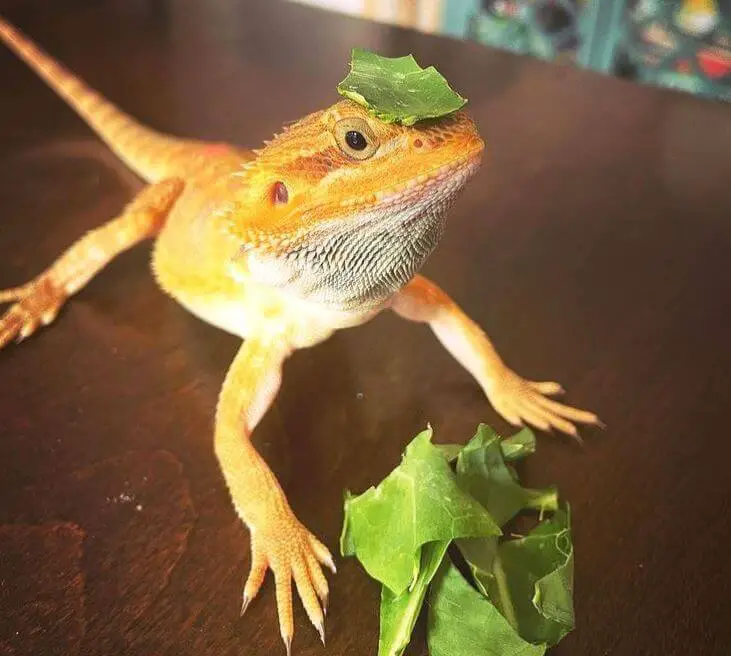
Insect meals cause firmer, thicker, and drier stools.
The stool of veggies is waterier and greener, and it can contain fiber that can not be digested.
The dragon’s appetite, diet, and temperature will decide how often he poops. Anything from 1 to 7 times a week is natural.
Looking at the poop and the poop habit is a good way to determine their health.
Watery or runny poo may indicate a health crisis. A parasitic infection generally.
When the stool looks strange, particularly has scents of dullness or your beardie needs to go a few times a day, do not hesitate to call a vet to know what is the cause.
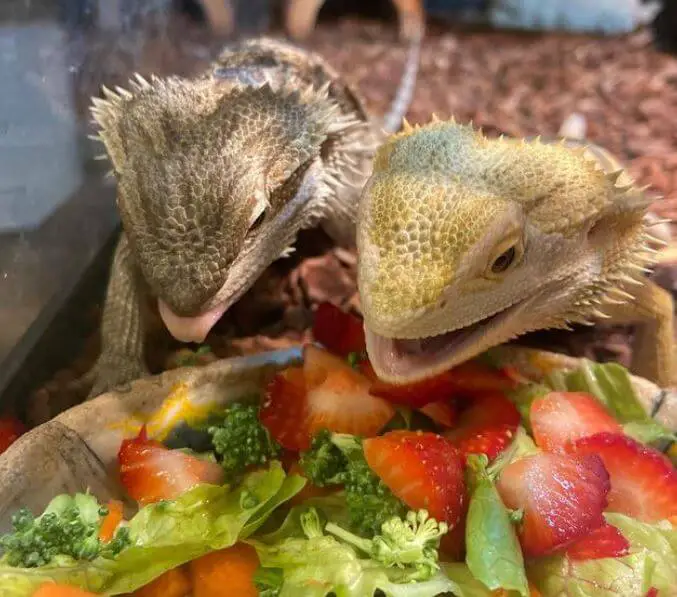
Read More:
- Can Beardies or Dogs Eat Pears?
- Can Beardies Eat Dill?
- Do Beardies Eat Squash?
- Can Beardies Eat Rosemary?
- Can Beardies Eat Chard?
4. Impaction
Bowel impaction occurs when an animal swallows indigestible things, which block the intestines.
Very often, your pet can accidentally eat rough substrates such as sand or insect chitin shells. Beetles or mealworms are too hard to digest.
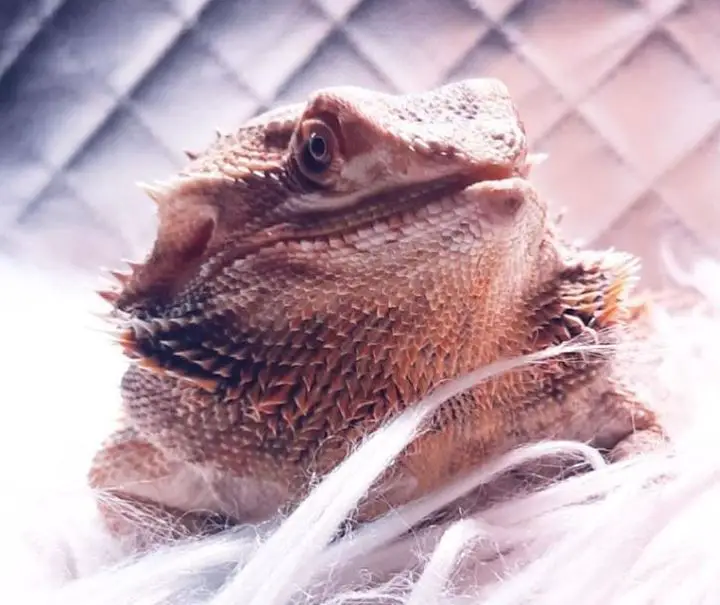
Bearded dragon symptoms of impaction are:
- Fail to pass excrement
- Swollen, bumpy, or hard stomach
- Loss of appetite
- Look painful and uncomfortable
Most of the impaction cases can be resolved by mixing olive oil with some applesauce in lukewarm water. Let the lizards bathe in there for 20 to 30 minutes, with a very soft massage.
This is home treatment and is suggested to do after consulting with a vet. Serious impaction cases need to be surgically treated.
5. Mouth Rot
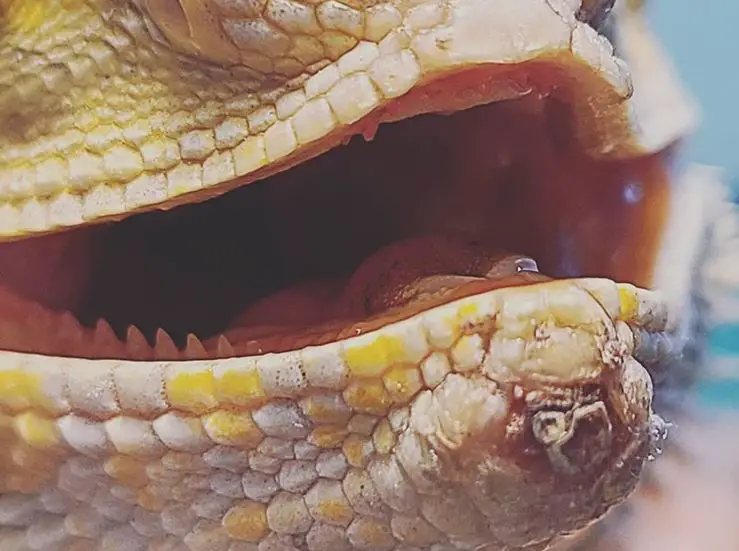
Mouth rot is a kind of mouth fungus that will hinder the dragon from fully eating. Several symptoms of mouth rot are visible:
- Yellowish or white substance on the sides and the corners of the mouth
- Mouth is swelling or abscess-like
- Loss of teeth
- Loss of appetite
Mouth rot requires emergency vet care.
6. Atadenovirus
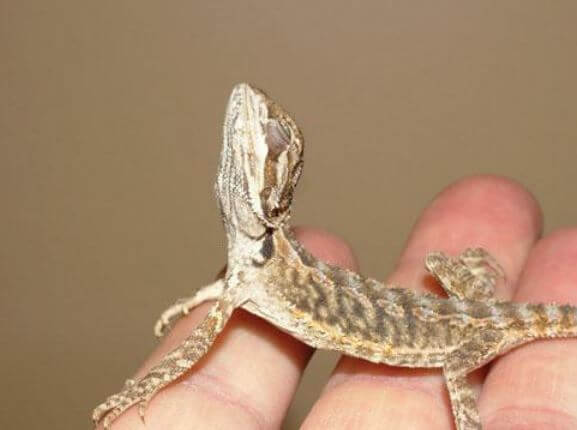
Atedenovirus is an extremely infectious viral infection that can kill your pet, particularly young and hatchling dragons.
Atadenovirus-affected juveniles are smaller and shorter than their remaining clutch.
The neurological signs begin to appear as the disease progresses. The dragon starts to look up for no reason and sometimes turns over.
The sick ones will stop eating and have trouble breathing or moving, and will suddenly die.
Unfortunately, there is still no medicine for atadenovirus. However, the treatment of the disease and the avoidance of spreading are both possible.
Affected beardies should be isolated from the other ones.
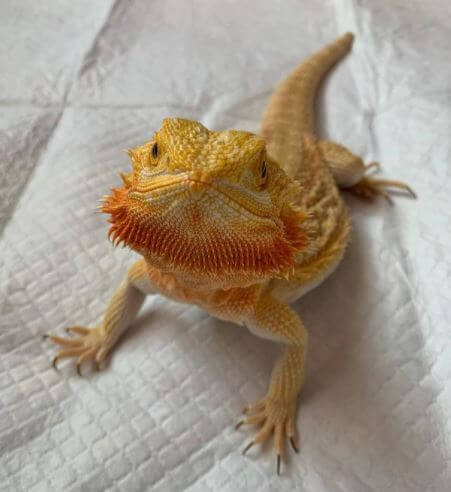
You should also never leave leftover foods, substrate, and appliances between tanks.
When buying a new pet, always go for the big and active young ones.
In the first three months, juveniles under the age of 90 days typically die. Any survivors may live a normal life but need special care.
You have to keep them warm, still provide UVB light, and sometimes check for parasites.
Signs of a young beardie that has atadenovirus:
7. Parasites
Every species can get parasites. There are two types of parasites: internal (intestinal) endoparasites and external ectoparasites, which live on the reptile’s skin.
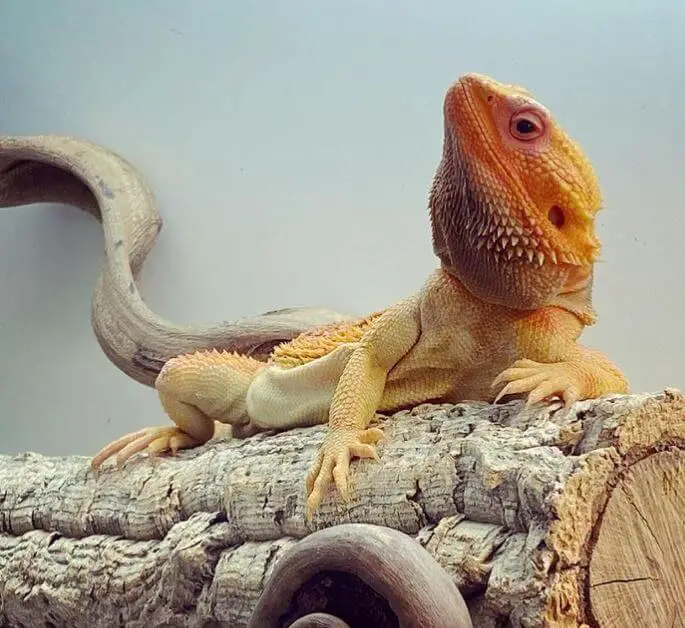
Some common internal parasites are pinworms, roundworms, hookworms, coccidia, etc. They all cause the same symptoms:
- Weight loss
- Vomiting or regurgitation
- Odd headache or diarrhea
- Bloody diarrhea
- Respiratory problems
The parasites must be identified by a vet by taking stool samples and conducting microscopic testing to assess the type and concentration of that parasite.
A reptile vet would prescribe the best beardie deworming treatment.
How many parasites there are is also important to know, since a small amount of certain species is not enough to cause symptoms.
The infection will start to flare up if the hygiene of the tank is bad.
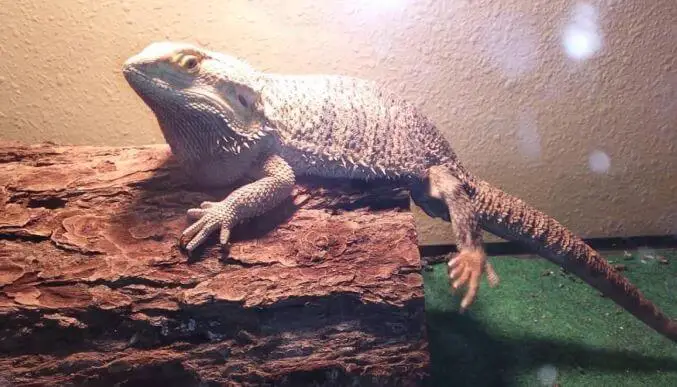
On the other hand, mites are the most prevalent external reptile parasites.
These tick relatives pierce the skin and suck blood. They are hard to kill and your pet might die from the chemical and the heat that kill the mite.
In the folds and crevices of the lizards, mites like to aggregate. Therefore, armpits, joints, and eye areas need careful care when carrying out inspections or treatment.
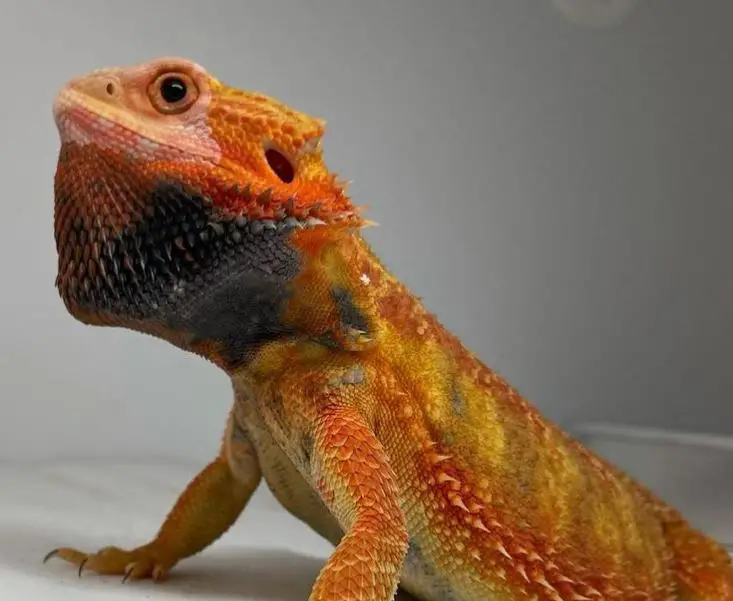
Some signs of mite infection include:
- Excessive soaking in water
- Scratching on the tank walls or any rough surfaces
- Tiny, red, or black dots on the body
- Visible mites on the tank
- Damaged skin
Mite infestations can also lead to mites transmitted to anemia, secondary infections, and other diseases.
Because mites are pretty hard to deal with, there are no therapeutical treatments that are 100% safe.
Consult a reptile vet and study all viable alternatives before continuing any cure.
Follow the directions to make sure that the reptile and yourself are safe.
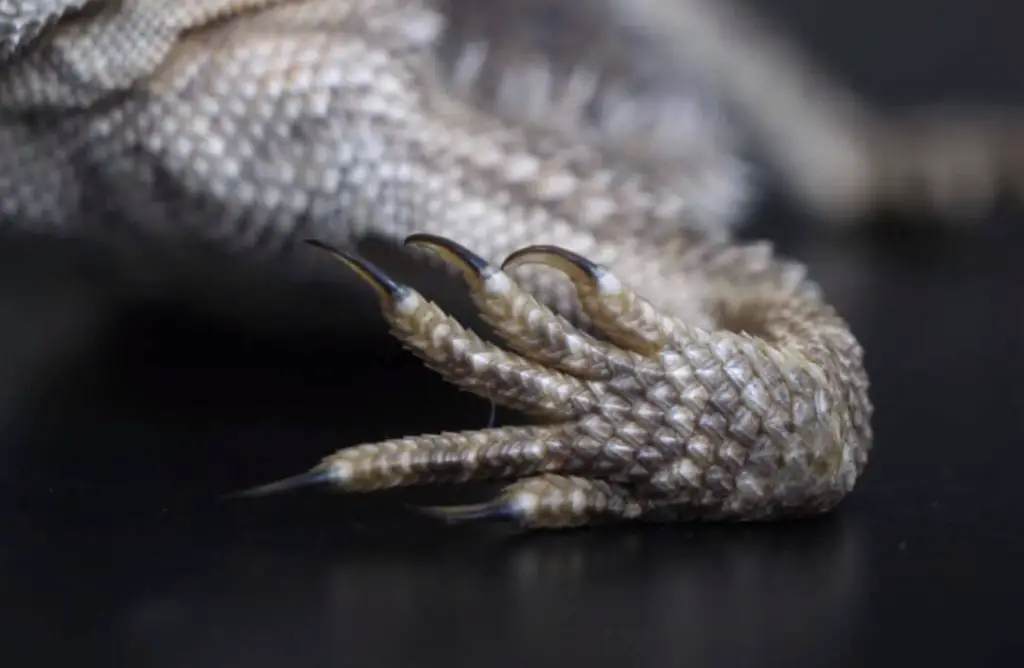
An absolutely safe (although not really as effective as insecticides) solution is giving warm baths with a minimal amount of betadine (povidone-iodine).
Betadine should be used on lizards and reptiles as a topical antiseptic.
However, as it may poison your pet, you should never submerge his head in the solution.
The very first step in parasite prevention is to maintain excellent hygiene in the tank.
It is also helpful to check your beardie and take the deworming treatments frequently.
Never let other dragons get close to him until you are 100% positive about his health and do not have any parasites.
If you buy a new dragon, quarantine him for several months. Moreover, remember not to cycle between tanks, food, and decorations.
Frequently Asked Questions About Bearded Dragon Body Language
1. How Can I Tell If My Bearded Dragon Is Happy?
You can know that your pet is happy and like being with you if there are no signs of provocation, just love.
If they don’t bite you, hump their head, puff their beard up when you get near, or sniff at you, it is good.
There are some easy signs they will show if they are happy with you:
- Close their eyes when you hold them
- Lay flat and look relaxed
- Climb on your side and let you handle them
- Lick your hand
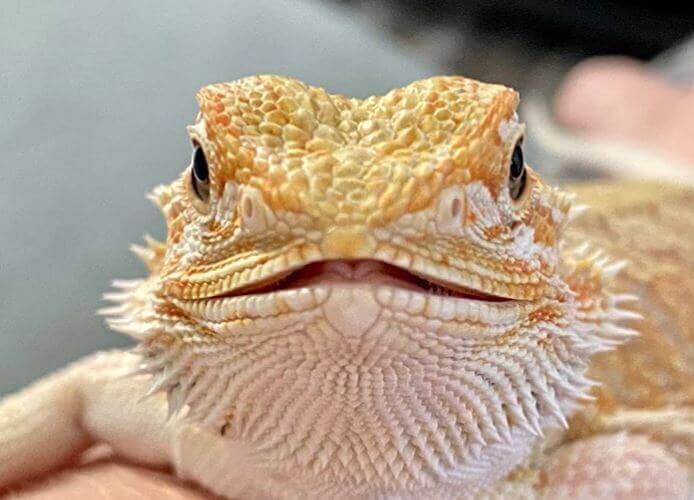
2. What Does It Mean When a Bearded Dragon Stares at You?
Beardies love to look at objects because they are curious and love to observe.
Moreover, a great deal of observation results from their entertainment and defense.
This is an instinctual activity that lets them appreciate the world and keeps them safe.
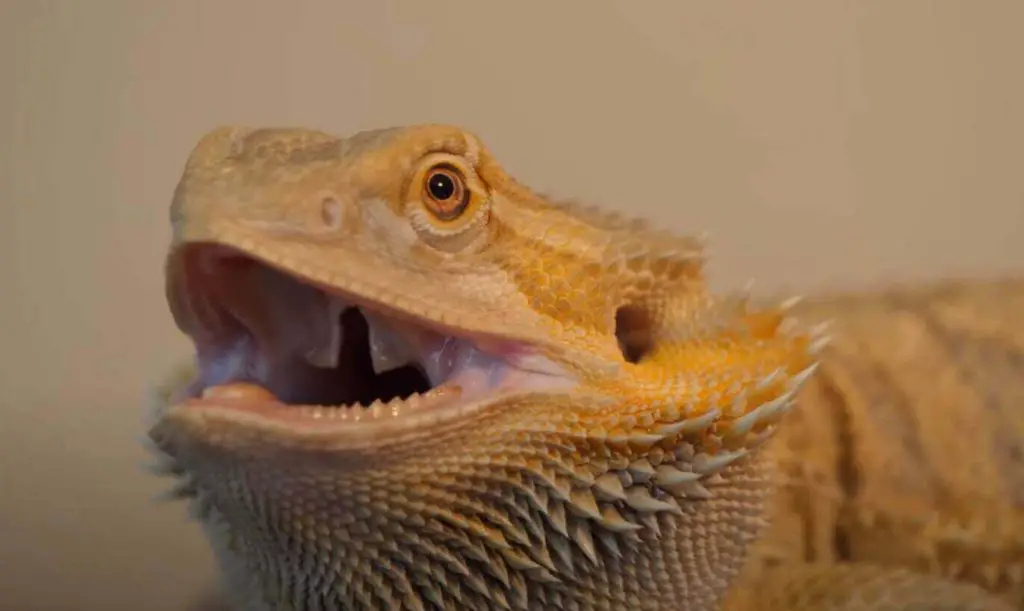
3. What Does It Mean When a Bearded Dragon Has His Tail Up?
When a bearded dragon raises its tail, he probably feels alert and takes his surroundings.
You also see this bearded dragon body language when they are hunting for prey, including roaches and crickets or moving objects.
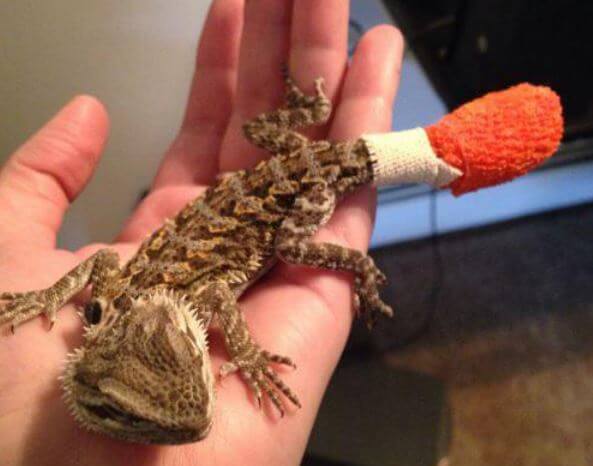
4. How Can I Tell If My Bearded Dragon Is a Male or Female?
To know the gender of a bearded dragon, you can use a flashlight and glow on the base of the threshold, over the vent on the upper side, and look at the underside.
On male bearded dragons, two hemipenal bulges or bumps are under the tale close to their anus. Each side of the tail is covered with these bulges.
On the other hand, female bearded dragons have just one hemipenal budge or bump at the same spot beneath their tail.
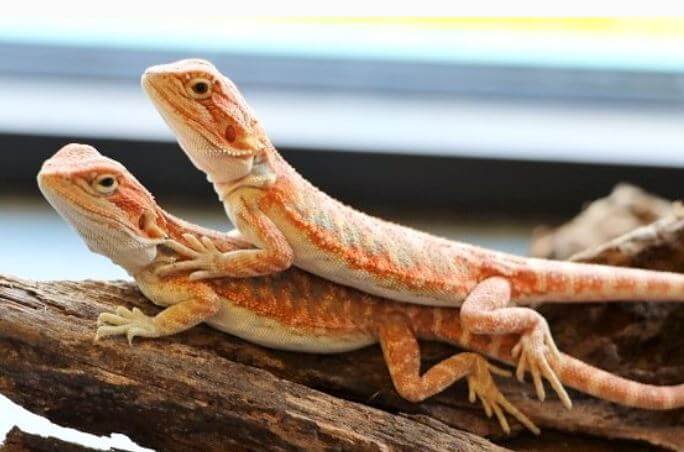
5. How to Tell If Your Bearded Dragon Is Shedding?
When your pet is going to shed, their skin gets really tight. You can also see a change in skin color.
It will still be sluggish, and then it will turn white. It is completely natural.
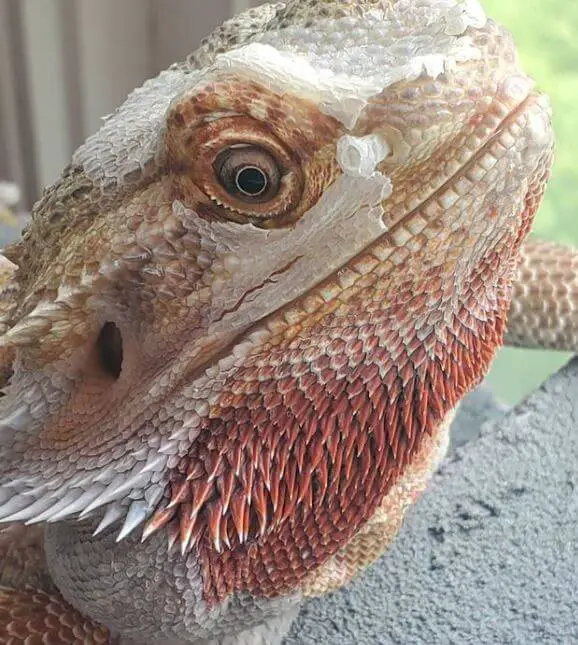
Signs of shedding include:
- Lethargy
- Appetite loss
- Skittish behavior
- Does not like to be touched
- Has skin patches
- Bloody inflation of the eyes (bearded dragons bulge their eyes to loosen the skin and sometimes this is the first molt area)
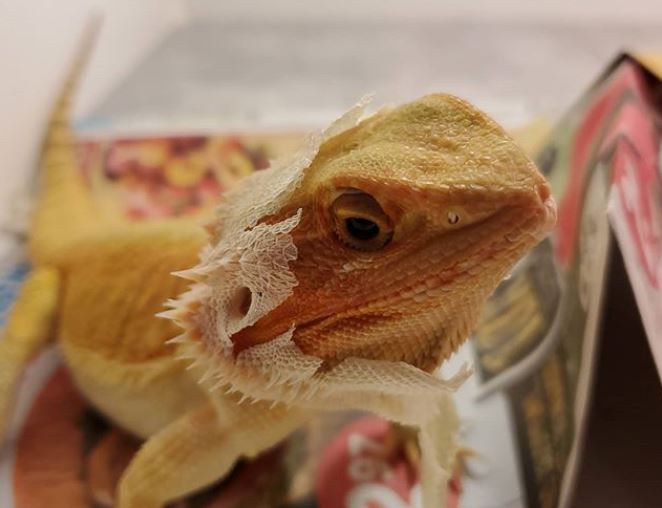
Conclusion
We hope that you got the best possible care for your beardies from our article and finally understood what they want to say to you.
Knowing the behavior and well-being of your pets is the secret to giving them the life they deserve.
Often, recognizing the warning signs can indicate a difference between life and death.
Do not hesitate to reach a vet, preferably a vet who specializes in handling reptiles, if you doubt the health of the bearded dragon.
Bearded dragon body language sometimes displays some quite weird behaviors. However, these actions are direct answers to something that is stressful or not desirable in their world.
That is why it is so important to understand what your pets are trying to say, so you can give them a healthy and happy life.
Key points for bearded dragon body language:
Bearded dragons are fascinating reptiles with distinct body language that conveys their emotions, needs, and state of mind. Learning to interpret their signals is crucial for understanding and responding to your pet’s needs effectively. Here are key points to consider when deciphering bearded dragon body language:
1. Head Bobbing:
- Head bobbing is a common behavior among bearded dragons.
- Males often head bob to assert dominance or signal their readiness to mate.
- In some cases, females may also head bob, especially during the breeding season.
2. Puffing Up:
- When a bearded dragon puffs up its body, it appears larger and more imposing.
- This behavior is often a sign of feeling threatened or territorial.
- It may be accompanied by darkening of their beard.
3. Darkening of Beard and Body:
- Darkening of the beard and body coloration is a clear indicator of stress, aggression, or discomfort.
- It’s essential to identify the cause and alleviate the stressor.
4. Beard Flaring:
- Bearded dragons can flare their beard, which is a soft, expandable throat pouch.
- This is typically a defensive display, indicating fear or stress.
- Beard flaring can also accompany head bobbing during territorial disputes.
5. Arched Back and Tail Raised:
- When a bearded dragon arches its back and raises its tail, it is usually preparing to defend itself or intimidate a perceived threat.
- This is often seen during territorial disputes.
6. Licking or Tongue Flicking:
- Bearded dragons may lick or flick their tongues when exploring their surroundings.
- This behavior helps them gather information about their environment.
7. Gaping Mouth:
- Gaping, or opening the mouth wide, is a behavior that can indicate overheating.
- It’s a thermoregulation method to release excess heat.
- Ensure proper temperature gradients in their habitat to prevent overheating.
8. Hiding or Burrowing:
- Bearded dragons may hide or burrow themselves in their substrate, indicating a need for solitude or a sense of security.
- This behavior is common when they are shedding, stressed, or gravid (carrying eggs).
9. Nodding or Bobbing When Approached:
- When a bearded dragon nods or bobs its head when you approach, it can be a sign of acknowledgment.
- Some beardies do this in response to their owners or perceived companions.
10. Basking and Stretched Limbs: – When a bearded dragon basks under its heat lamp with stretched limbs, it’s thermoregulating to maintain its body temperature. – This is a comfortable and content posture.
11. Glass Surfing: – Glass surfing involves repeatedly running along the enclosure’s glass walls. – This behavior may indicate stress, boredom, or a desire for more space or attention.
12. Color Changes: – Bearded dragons can change their body coloration, becoming lighter or darker in response to various stimuli. – Understanding the context of the color change is important in interpreting their mood.
In summary, bearded dragon body language is a complex and nuanced way of communicating their needs and emotions. By observing and understanding these signals, you can provide a more enriching and stress-free environment for your pet. Regular interaction and responsive care based on their body language will help you build a strong bond with your bearded dragon and ensure their well-being.
Further Reading:
- Best Bearded Dragon Accessories for Great Owner
- 7 Best Bearded Dragon Starter Kit
- How to Pick Up a Beardie
- Beardies Habits Shortlist
- Can Bearded Dragons Get High?
- Best Tortoise Enclosure: Complete Guide

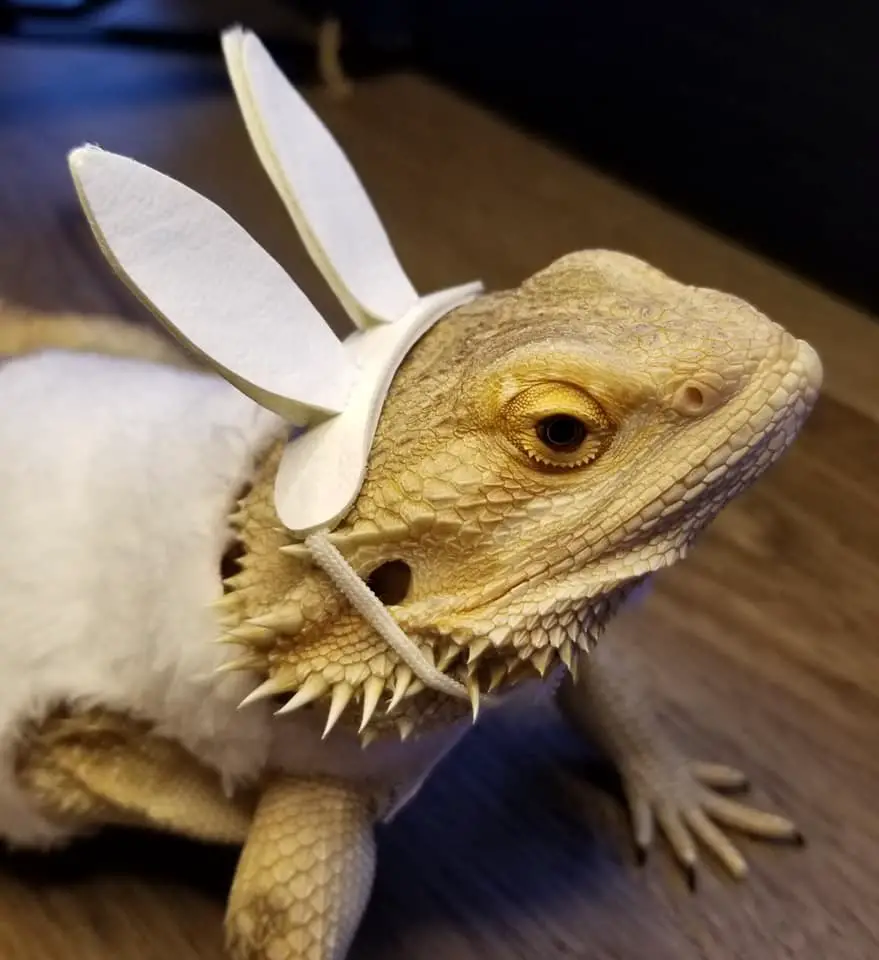

2 Responses
When I have a new BD, I do not understand many habits of BD and tell me why? why he do it?
Luckily, I find some information about this and find this article. This has enough to understand my pet. Sometimes, he is so crazy and so interest. My daughter said that he really loves water and bath in a while. I am so happy to have him and hope he will be a member of my family forever. Thank you!
Every single day, I usually see different activities and I have not understood this. So, I practice searching for new info on the internet like your website. And, yeah, I see this, a full of list habit and weird activities, which is so interest. Just say: Thank you! I will share this with other BD feeders.